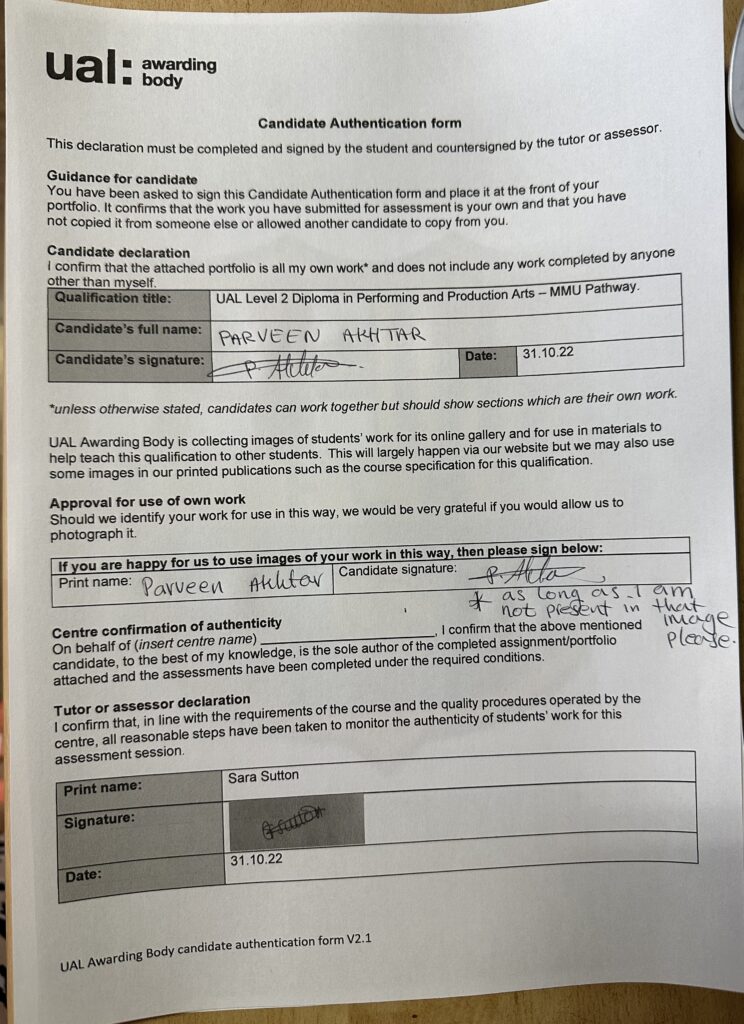Introduction – week 1
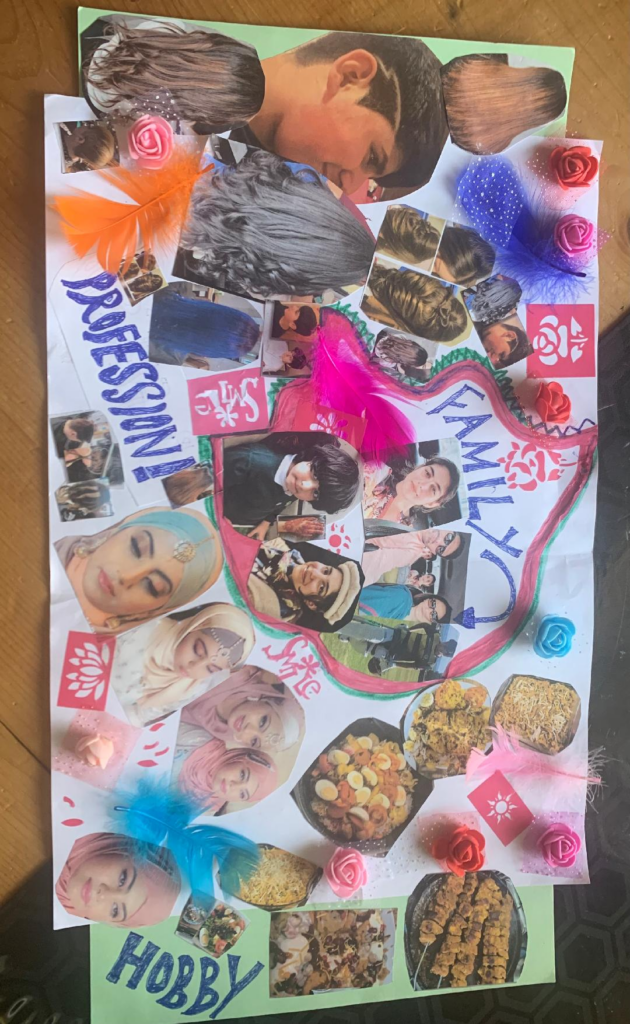
This is the mood board of -Parveen, on there is my family- husband Zafar who I have been married to for 16 years, he is a great Cricket player. My daughter Umaima is 13 years, she is at Gramma School year 9, also do scoring for cricket games. My son Aayan is 12 years old and has just joined the Gramma school year 7. He loves supports and is representing Halifax cricket.
I am qualified as hairdresser (level 2) won the competition second place. Barber (level 2) won the competition at 1st position. Beautician (level 2) though I have done Health and Social Care (level 2) and Administration (level 2), I have always enjoyed hair and makeup more, so I want to lead my profession in makeup and hair, I have added some of my hair colour, cuts and styles on my mood-board.
my hobbies- I have added some pictures of the food that I have cooked at home. I wanted my family to be healthy and stay away from fast food, so I started creating different dishes by watching cooking videos on YouTube.
proposal
I was given a task to research Criminal Character of Victorian times as it was not clear about what the project character would be, So I started my search for the most known criminal of Victorian times that was Jack the Ripper. I searched on google and copied some related information for my project.jack the ripper – Search (bing.com)

Who was Jack The Ripper?

The case of Jack the Ripper has long been one of Britain’s most talked-about mysteries but does this evidence, taken from the shawl of a victim, finally reveal his identity?
Today, London’s Whitechapel district is a popular destination for anyone visiting London. Travelers visit the gallery, take in the street art, and enjoy the many different food options that can be found in the area.
In 1888 however, this was not the case. Whitechapel was plagued with economic neglect and was an overcrowded slum riddled with poverty. This would prove to be the perfect area for Jack the Ripper to carry out his murders.
The crimes of Jack the Ripper
While Jack the Ripper was linked with many murders in the Whitechapel area, it is widely believed that there are five murders of a similar nature that can be credited without a doubt to the serial killer.
Mary Ann Nichols, Annie Chapman, Elizabeth Stride, Catherine Eddowes, and Mary Jane Kelly are all believed to have been Jack the Ripper’s victims. The five women were all brutally murdered. Incisions to the throat and abdomen were something of a trademark for Jack the Ripper, leaving no doubts as to why he quickly spread fear and panic throughout the area.
Police worked hard to identify the killer but to no avail. The case of Jack the Ripper was particularly notable as it was the first of its kind in the sense that it created a media frenzy. The press was quick to jump on the story of the killer, which played a huge role in spreading fear and panic over the murders.
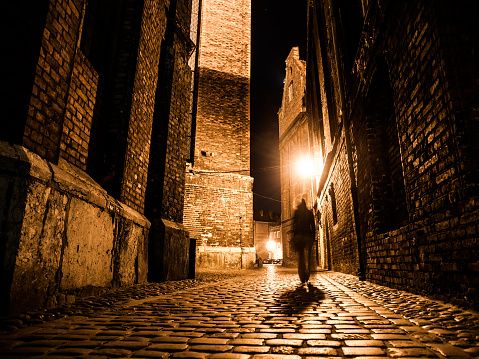
Whitechapel
The letters reportedly from Jack the Ripper
Throughout the police investigation, they received hundreds of letters claiming to be the killer. Of course, the majority of these letters could be cast aside as fraudulent, but one, in particular, stood out to the authorities as potentially genuine. A letter addressed as coming ‘From Hell’ was received by George Lusk of The Whitechapel Vigilance Committee. The letter came with a small box containing half a human kidney and claimed that the other half had been eaten.
The evidence that proves the identity of Jack the Ripper
Earlier in the year, DNA evidence emerged that suggests we can identify the true identity of Jack the Ripper. A shawl found by the body of Catherine Eddowes that contains ‘forensic stains’ has been used to identify the killer as Aaron Kosminski, a 23-year-old barber from Poland. The analysis also suggests the killer had brown eyes and hair, a description that Kosminski fit.
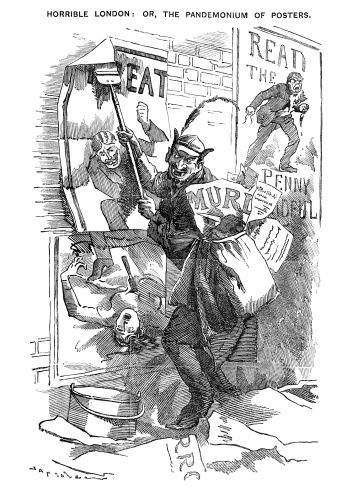
Satirical cartoon about Jack the Ripper
The Jewish immigrant has long been linked with the crimes, but this is the first piece of forensic evidence that gives any sort of clear proof as to the killer’s identity. The Journal of Forensic Sciences published the study, who used DNA from a living relative of Kosminski. Kosminksi would go on to be put in an asylum following the alleged murders, where he died young.
While there are those who say we don’t have enough evidence to name Kosminski as the killer, the DNA on the shawl undoubtedly brings us closer to knowing the true identity of Jack the Ripper.
https//britishharitage.com/history/ Jack the Ripper’s true identity (britishheritage.com)
Context
Was not clear about the role of my model character. But the project is based at Bradford Police Museum and the theme is ghosts, characters from Victorian times between 1837 – 1901. now that I have been introduced to my media model (Rose) she has clarified she is playing a character of Bretha (young girl who stole milk) Ghostly Encounters – at Bradford Police Museum
I have researched using google about the character and found very little information about this girl. so instead I have searched other homeless girls of Victorian time and in imagination I believe she had no family and lived on streets, in very dirty cold/hot weathers. no food available- therefore she had to steal food to survive, and lived in very fearful day to day life of getting court by the police and the punishment was very strict and children faced same harshness as adults, as no law of mercy was there for younger children.
Sense the oppressive atmosphere from inside the cells where 1000s of violent criminals and murderers were confined and where visitors can still experience an oppressive presence where the lingering souls of former prisoners may be still stalking the corridors and cells. You may sense the presence of the spirit of a young Victorian girl named Bertha who has been reportedly seen sat in one of the cells? In custody for stealing milk.
I have researched many character’s of homeless young girls of Victorian time on google. [email protected]
Hear about the paranormal events that have been experienced by guides, visitors, security and police officers over the years; cold spots, flying objects, computer malfunctions, equipment infestations, foul smells, orbs and phantom figures caught on camera or glimpsed on the edge of vision.
Week 2
I was introduced to my model(Rose) today. Latex patch test was supposed to be carried out on the models skin (for the lash glue or any other latex used for the performance day), but she told me that, she suffers from PCOS (polycystic ovary syndrome- hormonal changes), has anaemia, her blood pressure can go up/down, and is allergic to latex, so with confirmation from Luci (tutor) I did not carry out the patch test and will not use any type of latex as makeover.
I applied small amount of foundation base to match on my model Rosa’s face skin tone, which was a challenge to mix many different foundation bases to match her exact tone, managed to match almost the tone, still slightly darker but Rosa was happy with that tone. We exchanged our email and contact number to discuss our project further in coming weeks.



I have forwarded Rose (Teams) some ghostly characters pictures to get some sort of ideas on what we can practice make up and costumes. At the moment my model is feeling completely empty headed, she keeps getting confused the costume side as well as weather she wants to play live or dead character? after conformation from my tutor sarah It is now confirmed the as the theme is Halloween/ghosts. It would look odd one out playing live character.
Some information about what the children in Victorian time faced and lived in.
How were crimes punished in Victorian times?
The penalty for the most serious crimes would be death by hanging, sometimes in public. However, during the Victorian period this became less popular form of punishment, especially for smaller crimes, and more popular were transported abroad (sometimes all the way to Australia) or sent to prison instead.
Poor sanitary conditions
Children and crime
Many destitute children lived by stealing, and to the respectable Victorians they must have seemed a very real threat to society. Something had to be done about them to preserve law and order.
Many people thought that education was the answer and ragged schools were started to meet the need. However, there were dissenting voices against this. Henry Mayhew argued that:
‘Since crime was not caused by illiteracy, it could not be cured by education … the only certain effects being the emergence of a more skilful and sophisticated race of criminals
Henry Mayhew was an investigative journalist who wrote a series of articles for the Morning Chronicle about the way the poor of London lived and worked.
In an article published on 24th September 1849 he described a London Street with a tidal ditch running through it, into which drains and sewers emptied. The ditch contained the only water the people in the street had to drink, and it was ‘the colour of strong green tea’, in fact it was ‘more like watery mud than muddy water’. This is the report he gave:
‘As we gazed in horror at it, we saw drains and sewers emptying their filthy contents into it; we saw a whole tier of doorless privies in the open road, common to men and women built over it; we heard bucket after bucket of filth splash into it’ (2).
Mayhew’s articles were later published in a book called London Labour and the London Poor and in the introduction he wrote:
‘…the condition of a class of people whose misery, ignorance, and vice, amidst all the immense wealth and great knowledge of “the first city in the world”, is, to say the very least, a national disgrace to us’ (3).
Destitution
Many cases of death caused by starvation and destitution were reported. One example of such a report will suffice. In 1850 an inquest was held on a 38 year old man whose body was reported as being little more than a skeleton, his wife was described as being ‘the very personification of want’ and her child as a ‘skeleton infant’(4).
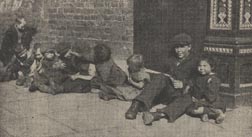 |
| Children of the street About this image https://www.hiddenlives.org.uk/articles/poverty.html https://www.nationalarchives.gov.uk/education/resources/victorian-children-in-trouble/ |
Homeless children
Obviously these conditions affected children as well as adults.
There were children living with their families in these desperate situations but there were also numerous, homeless, destitute children living on the streets of London.
Many children were turned out of home and left to fend for themselves at an early age and many more ran away because of ill treatment.
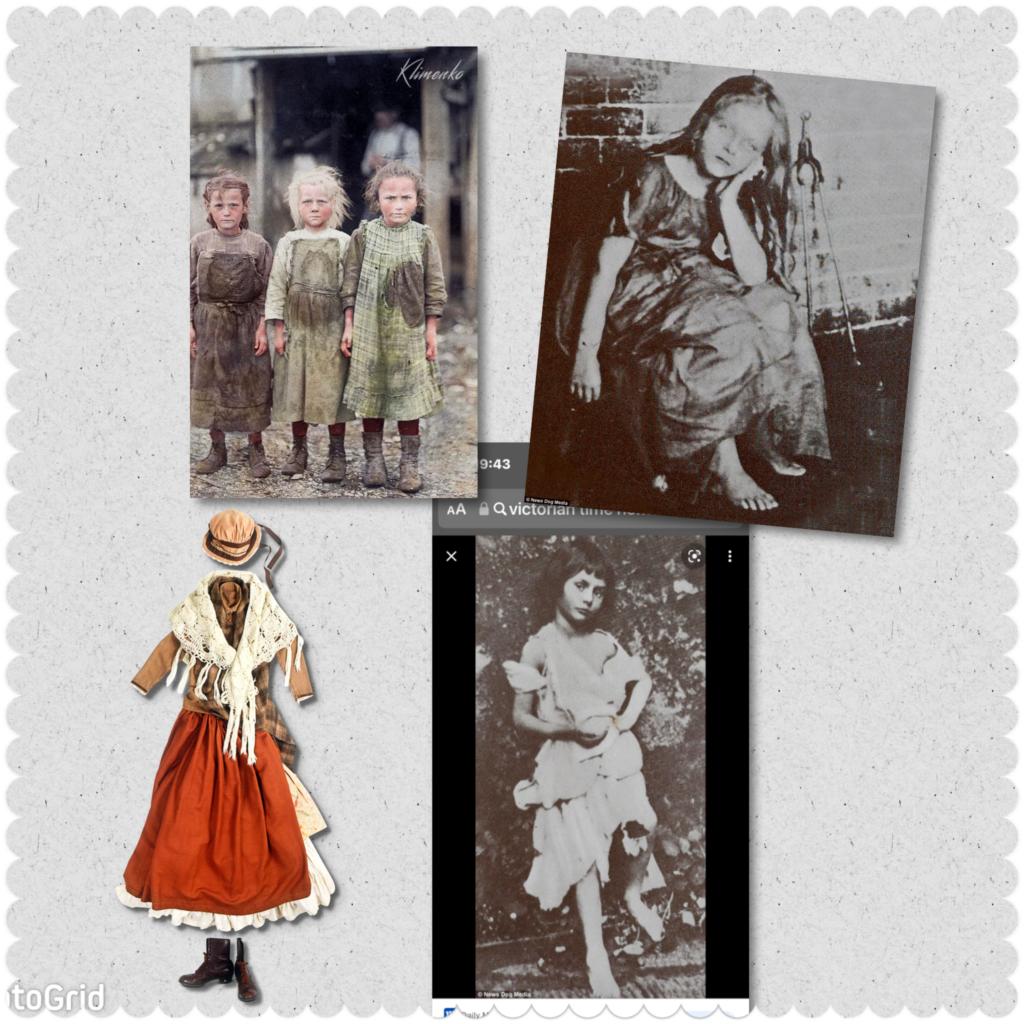
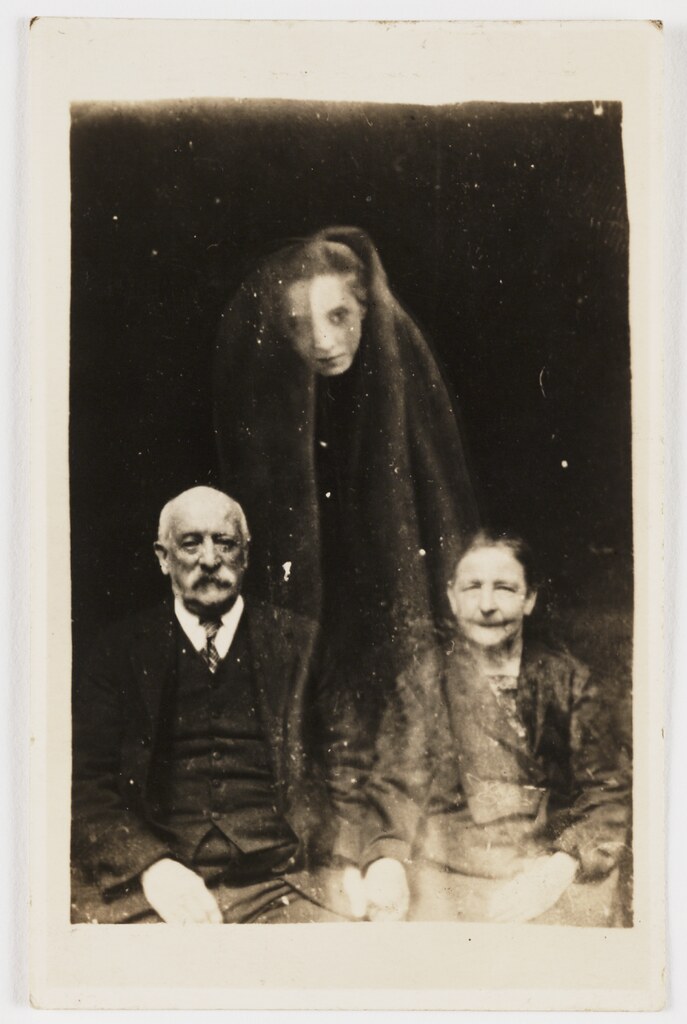
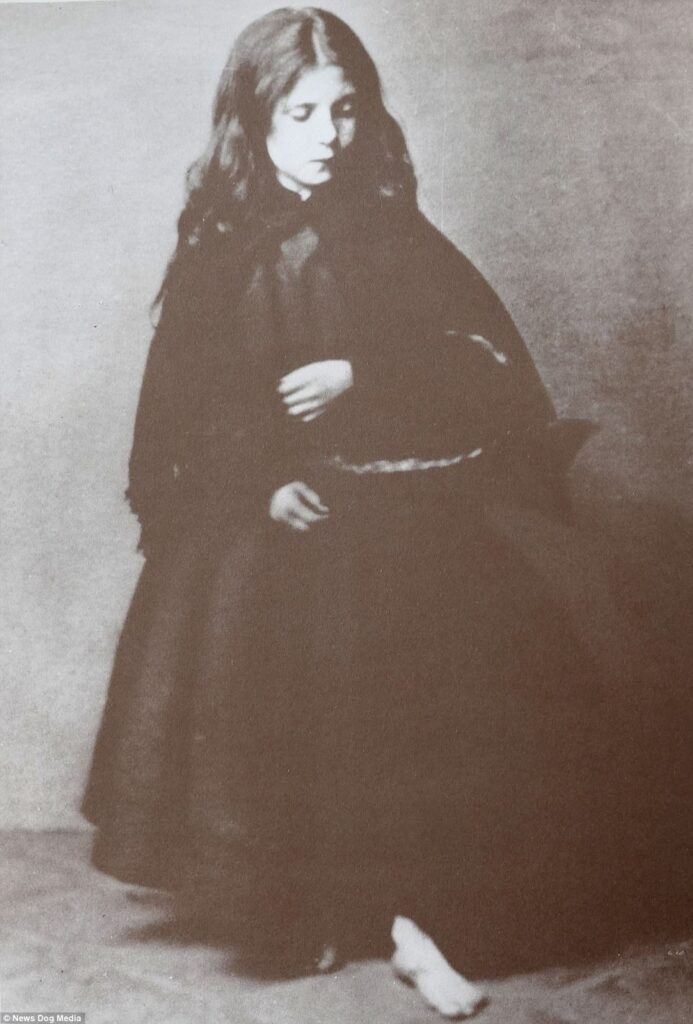

Why Do People Believe in Ghosts?
Why do people believe in ghosts? People believe in ghosts for various reasons whether that be a religion reason, why is there not more to life after death, it’s thrilling, gives people a sense of comfort and there is ‘proof’ some may say.
If you believe in ghosts, you’re not alone. Cultures all around the world believe in spirits that survive death to live in another realm. In fact, ghosts are among the most widely believed of paranormal phenomenon: Millions of people are interested in ghosts, and thousands read ghost stories on Reddit every day. It’s more than mere entertainment; A 2019 Ipsos poll found that 46% of Americans say they truly believe in ghosts. (The nation is discerning in its undead beliefs; only 7% of respondents said they believe in vampires).
The idea that the dead remain with us in spirit is an ancient one, appearing in countless stories, from the Bible to “Macbeth.” It even spawned a folklore genre: ghost stories. Belief in ghosts is part of a larger web of related paranormal beliefs, including near-death experience, life after death, and spirit communication. The belief offers many people comfort — who doesn’t want to believe that our beloved but deceased family members aren’t looking out for us, or with us in our times of need?
People have tried to (or claimed to) communicate with spirits for ages; in Victorian England, for example, it was fashionable for upper-crust ladies to hold séances in their parlors after tea and crumpets with friends. Ghost clubs dedicated to searching for ghostly evidence formed at prestigious universities, including Cambridge and Oxford, and in 1882 the most prominent organization, the Society for Psychical Research, was established. A woman named Eleanor Sidgwick was an investigator (and later president) of that group, and could be considered the original female ghostbuster. In America during the late 1800s, many psychic mediums claimed to speak to the dead — but were later exposed as frauds by skeptical investigators such as Harry Houdini.



What is the true meaning of Halloween?
“Hallow” — or holy person — refers to the saints celebrated on All Saints’ Day, which is November 1. The “een” part of the word is a contraction of “eve” — or evening before. So basically, Halloween is just an old-fashioned way of saying “the night before All Saints’ Day” — also called Hallowmas or All Hallows’ Day.
Why Do We Celebrate Halloween?

Halloween has been around for more than a thousand years. Originally a religious observance, it became increasingly secular over the centuries until its religious trappings all but disappeared. Today Halloween is considered a holiday for dress-up and fun, especially for children.
Halloween’s origins can be traced back to the ancient Celtic festival known as Samhain, which was held on November 1 in contemporary calendars. It was believed that on that day, the souls of the dead returned to their homes, so people dressed in costumes and lit bonfires to ward off spirits. In this way, popular Halloween tropes such as witches, ghosts, and goblins became associated with the holiday.
In the 7th century CE, Pope Boniface IV created All Saints Day, originally celebrated on May 13. A century later, Pope Gregory III moved the holiday to November 1, likely as a Christian substitute for the pagan festival of Samhain. The day before the saintly celebration became known as All Hallows Eve, or Halloween.
Though the holiday began in Celtic regions of Ireland, the United Kingdom, and France, it quickly spread to other parts of the world. The first American colonists in New England were forbidden to celebrate it for religious reasons, though it enjoyed some popularity in the Southern colonies. By the 1800s, fall festivals marking the seasonal harvest incorporated Halloween elements, and Irish immigrants escaping the devastating Potato Famine brought with them many Halloween traditions that remain today.
The custom of trick-or-treating, in which children dress up in costume and solicit treats from neighbors, became popular in the United States in the early 20th century as Irish and Scottish communities revived the Old World custom of “guising,” in which a person would dress in costume and tell a joke, recite a poem, or perform some other trick in exchange for a piece of fruit or other treat. By 1950, trick-or-treating for candy had become one of Halloween’s most popular activities.
https://www.britannica.com/story/why-do-we-celebrate-halloween
Additional Assessment Evidence
Analysing the Skin and Types


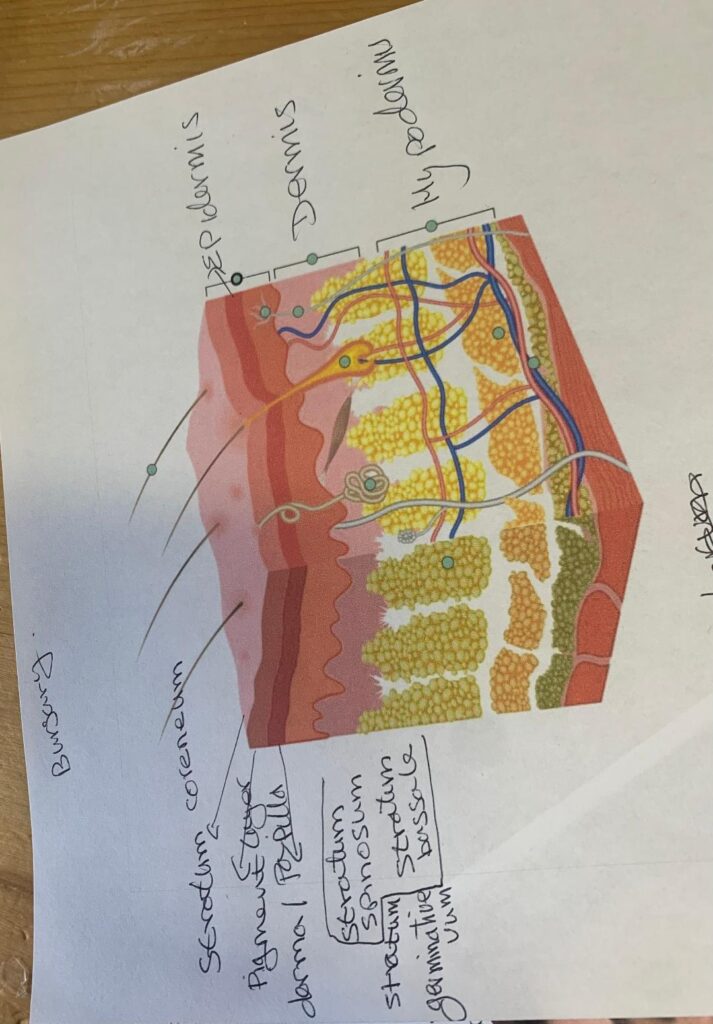
looked at colour wheel and Skin undertones.


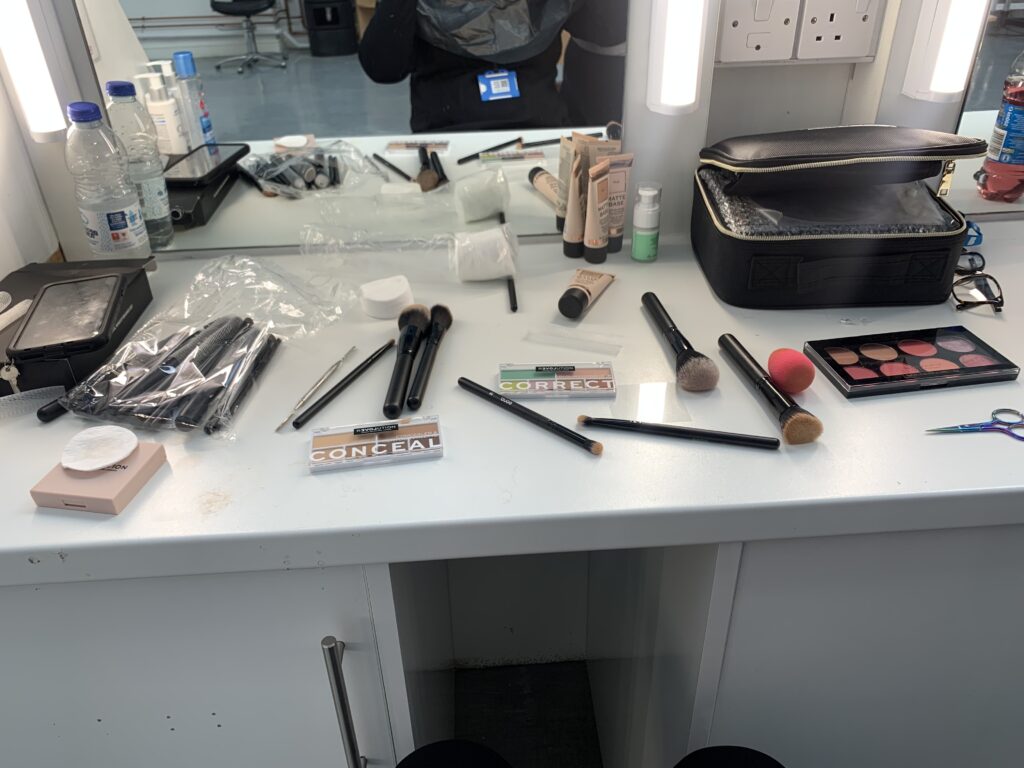
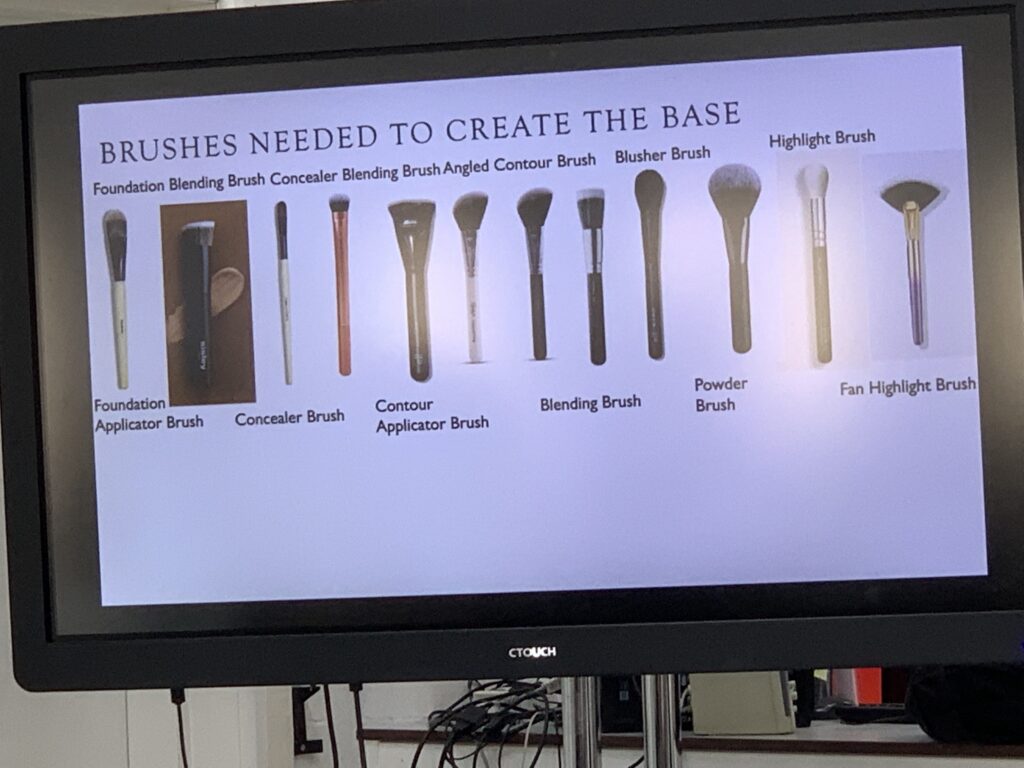
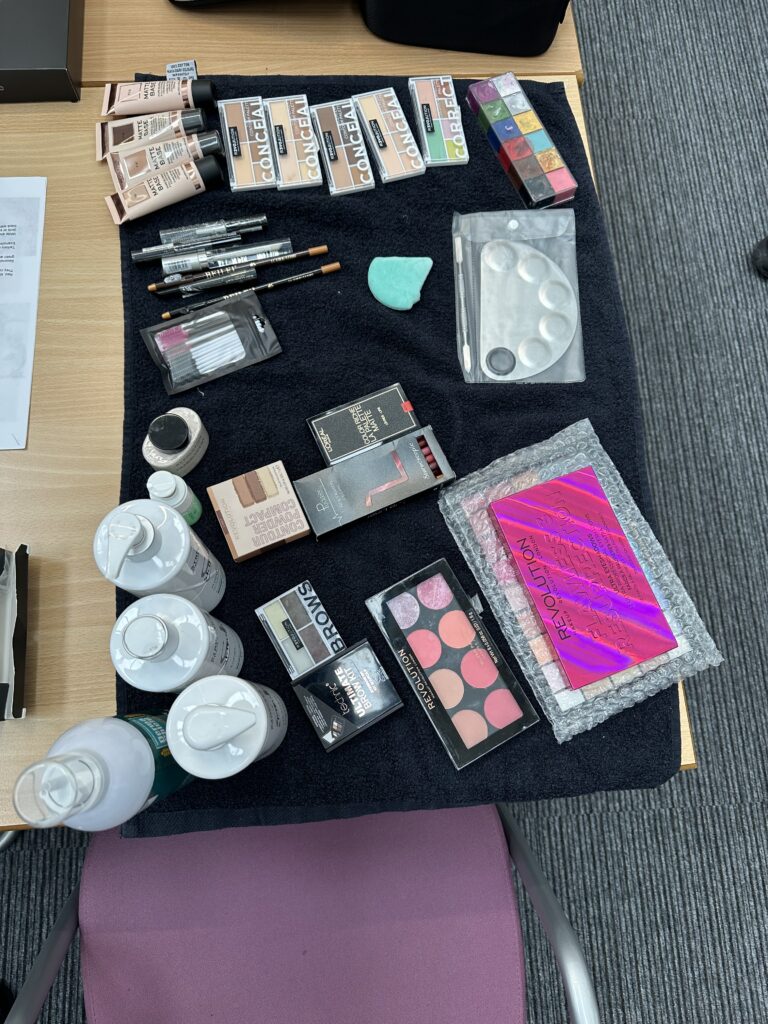
we got to look at the makeup kit and the makeup brushes today.

First time using make up in the class, we had demo by Luci and we had a go after to set the base and contour features.
Was given colourful charts to select the colour theme to do with each other and mixed cream /waterbased face colours to match our partners skin tone as a foundation base or concealer, which went fairly well, then got to complete the facial makeup, my partner choose blue theme so I created blue eyes and pink lips with blue eyeshadow to match the look.
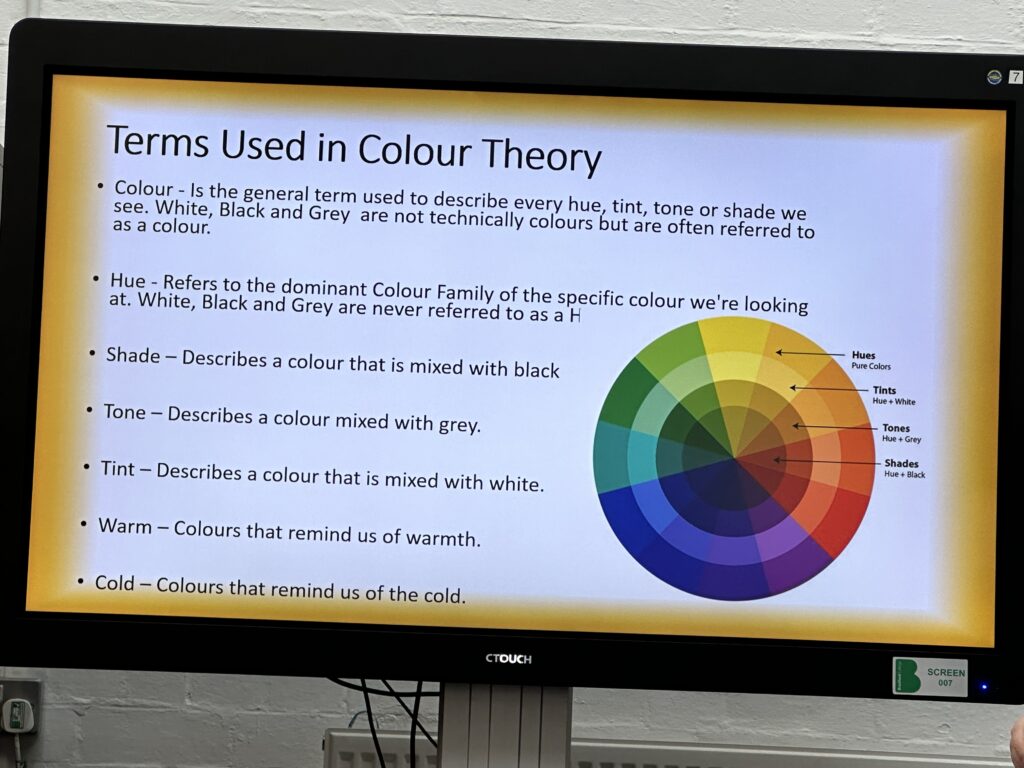
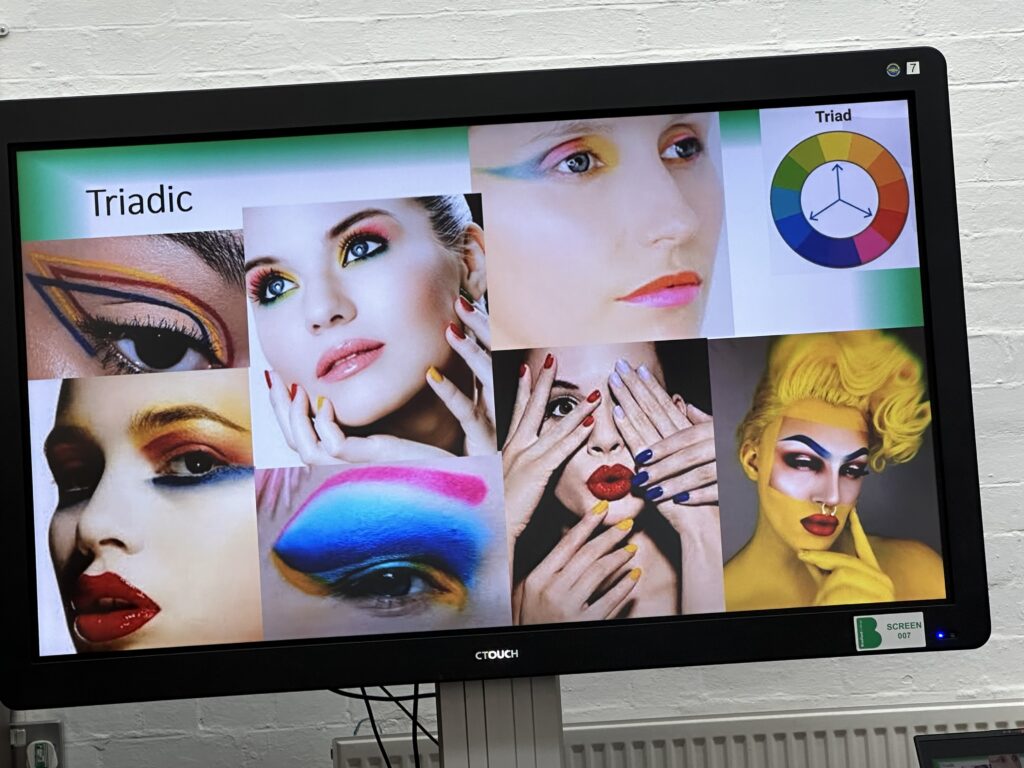

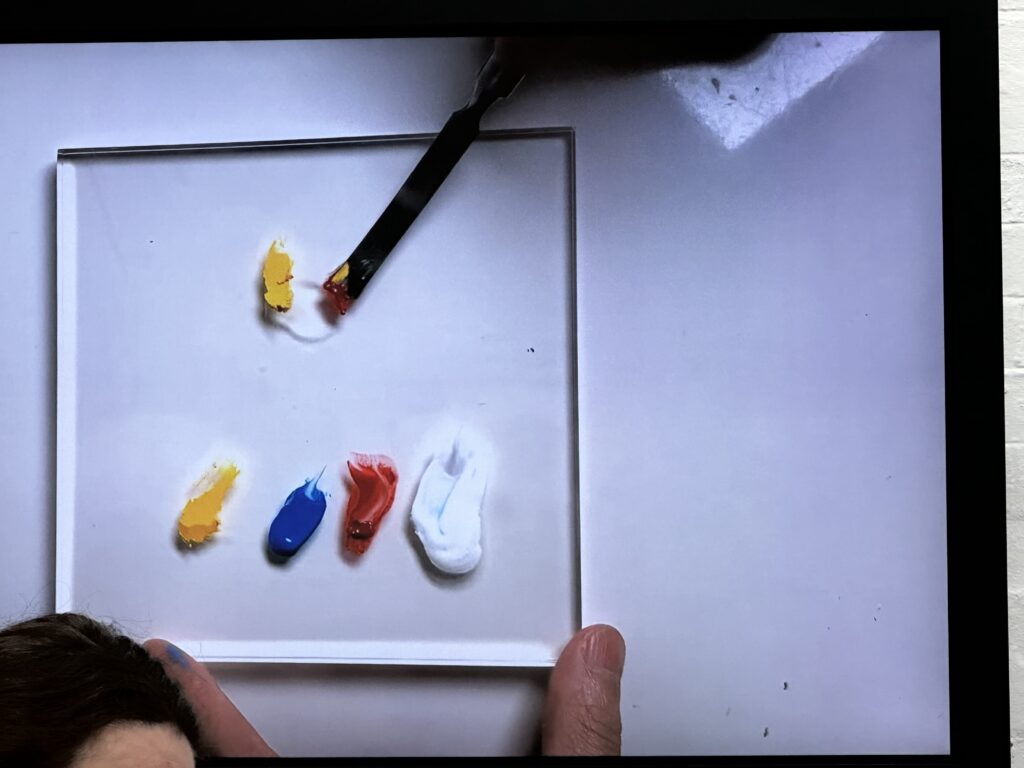
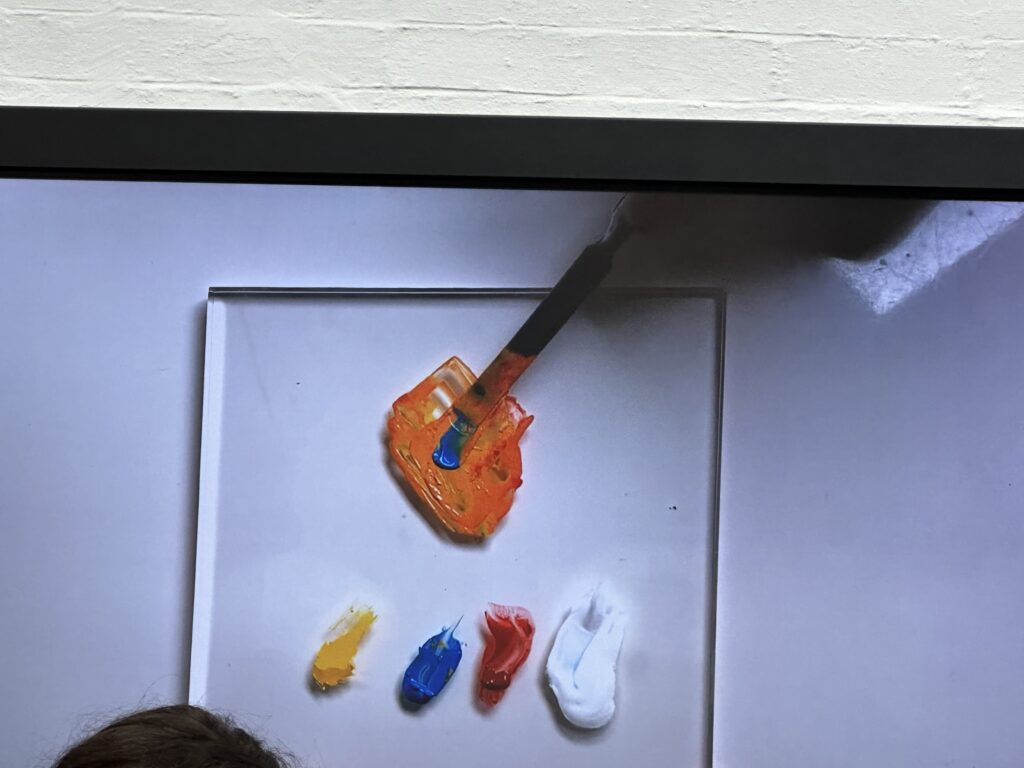

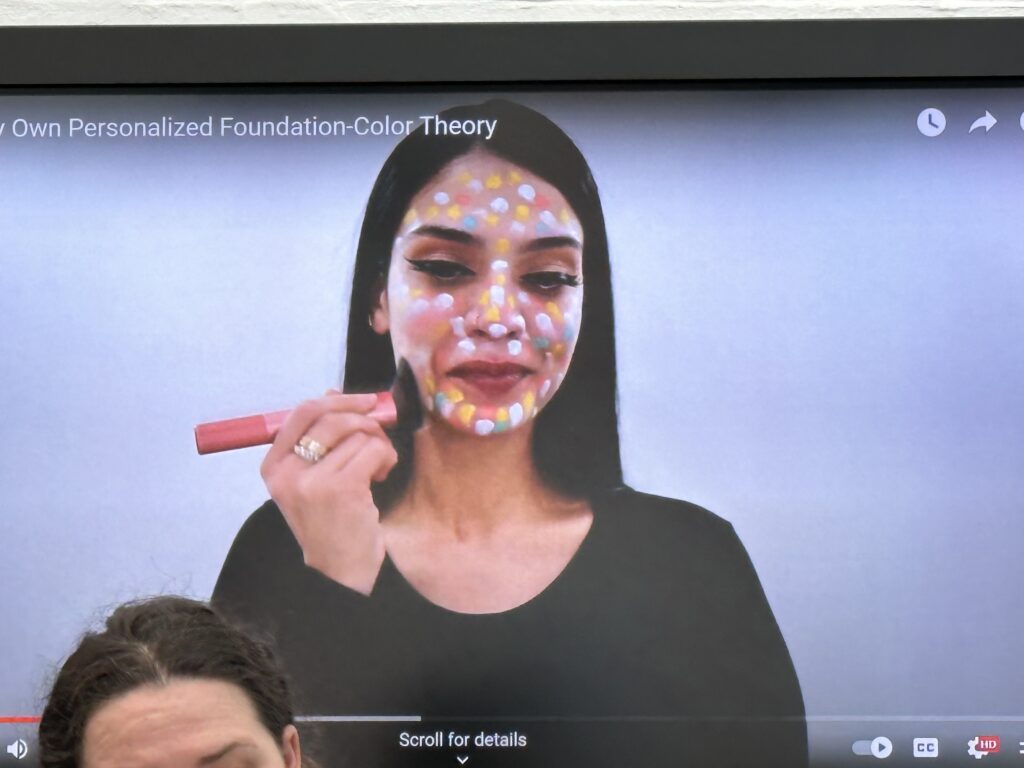
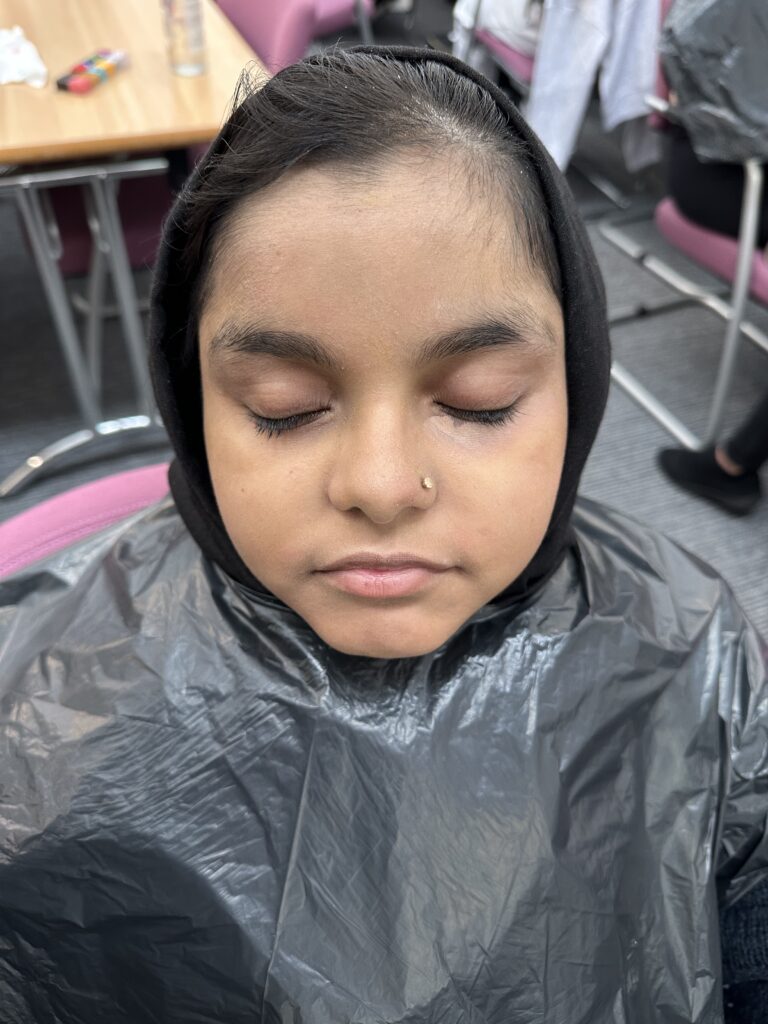
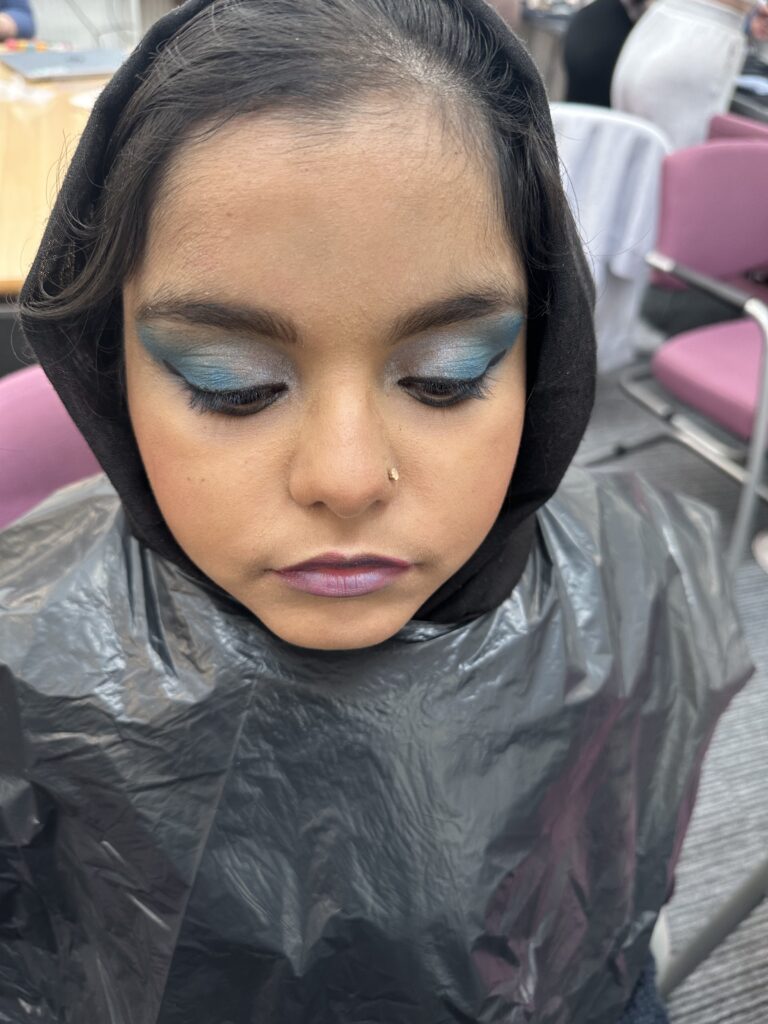
got to learn the depth of hair cortex and used products and tools to curl/straighten hair for when we do makeup we must complete the look by doing hair also to compliment full look and not just the face
Hair- The Cortex
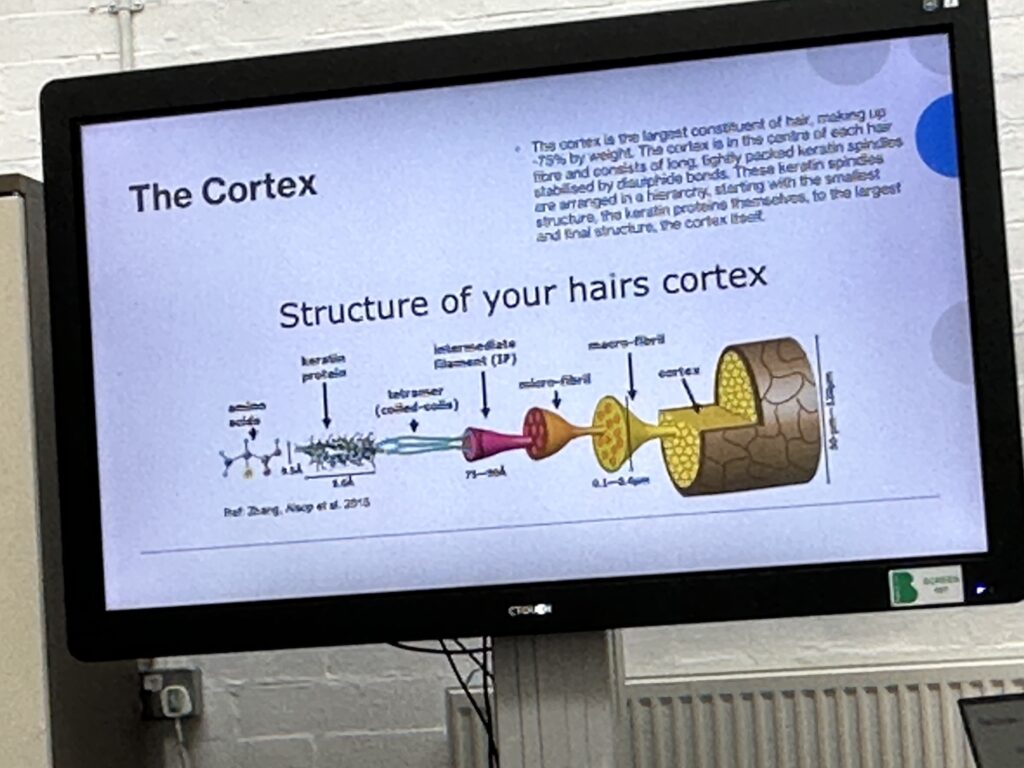
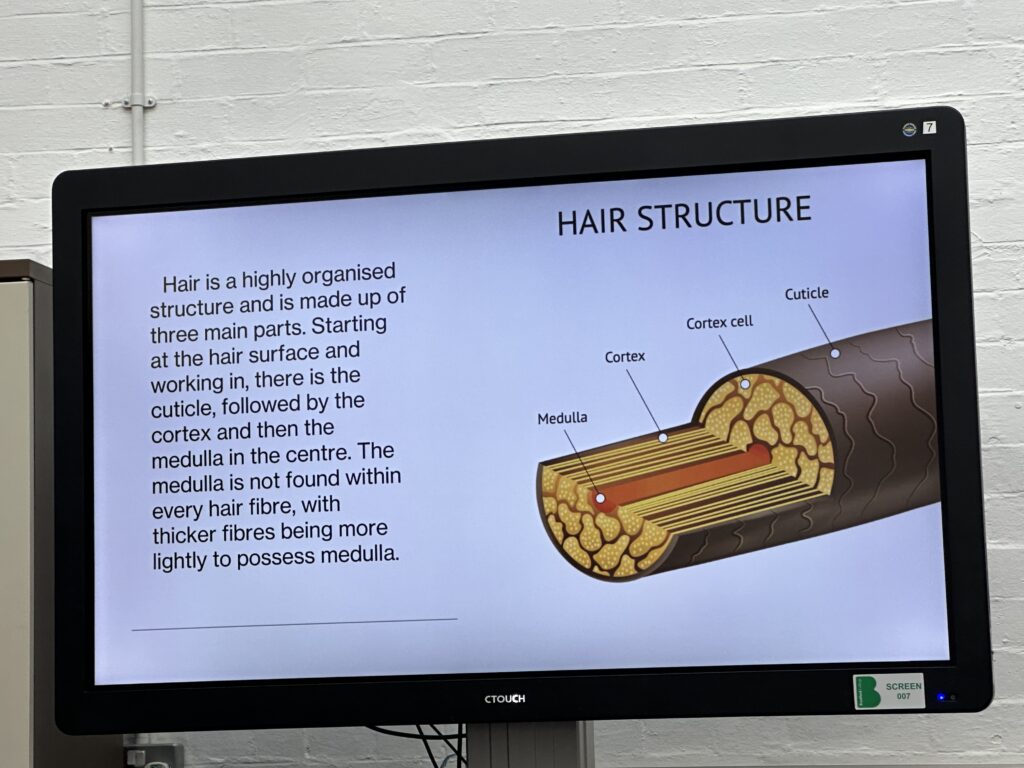
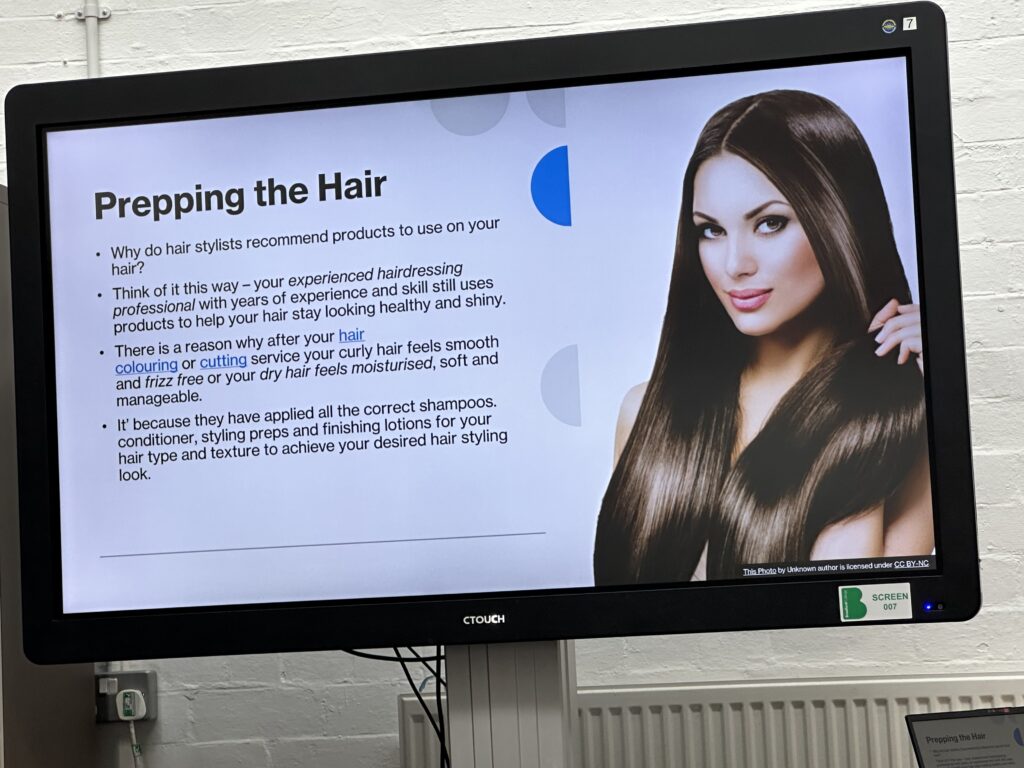

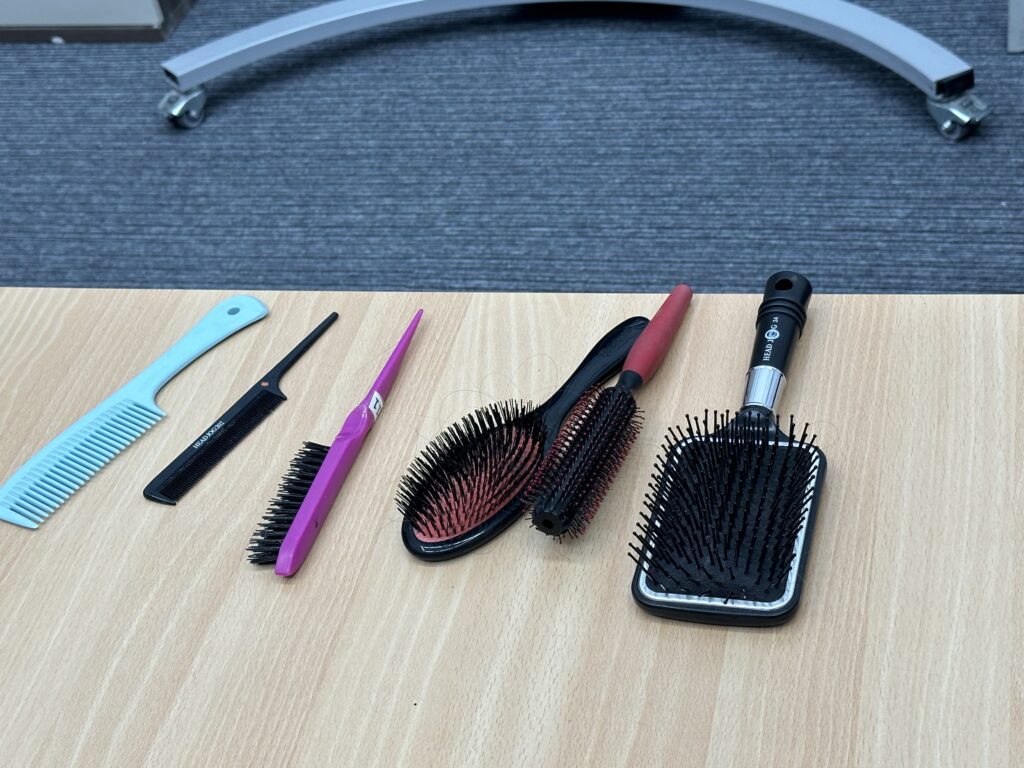
Body Paint
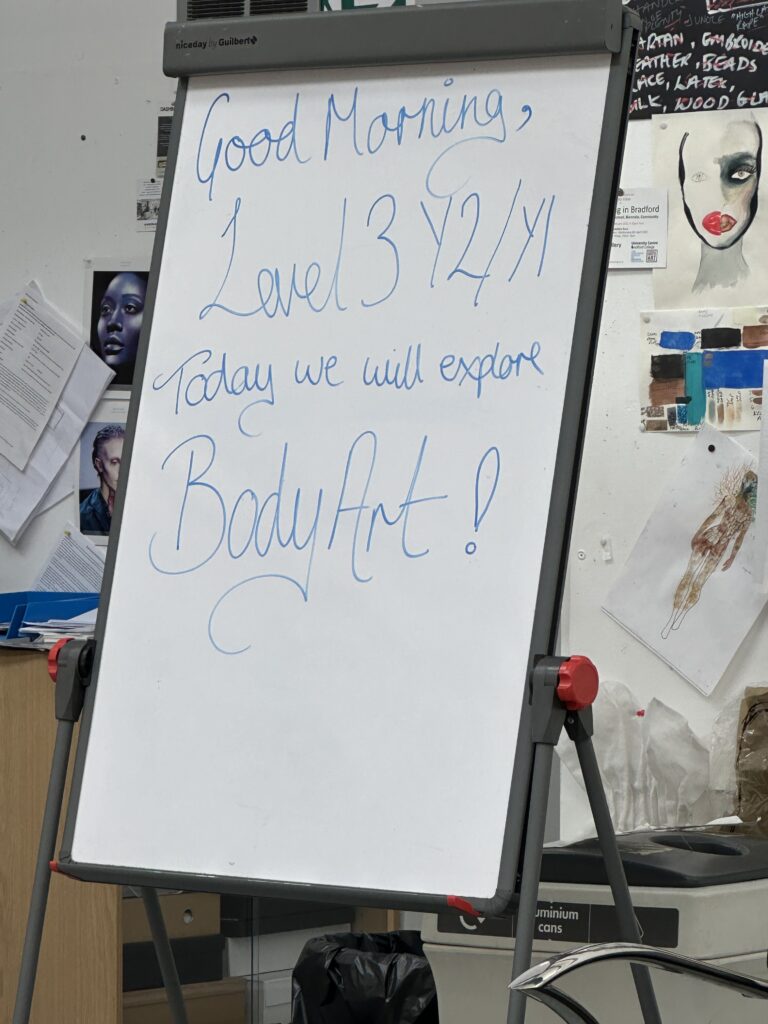

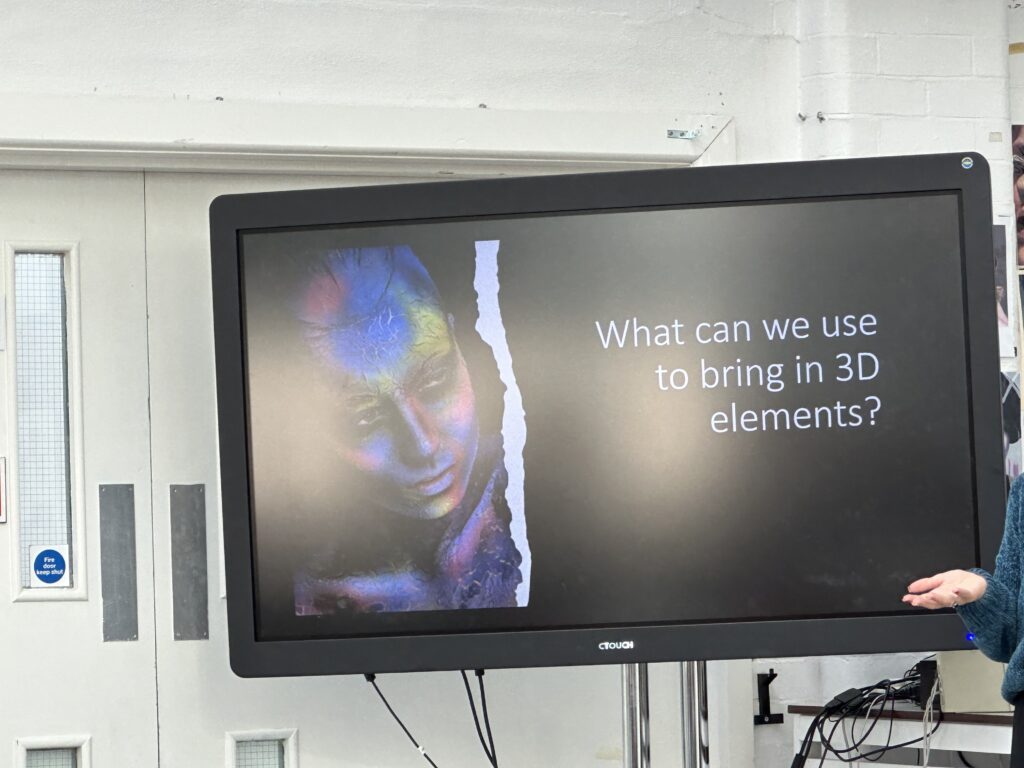


we got shown demo by Luci of body paint then we got to do it on our model to practice special effects of ghost looks Victorian times. by using white Bruise wheel paint as a base applied to the face and body. I prepped the skin by cleanse, tone and moisturise, before applying the paint. I covered full face, neck and the shoulders with white paint then used red and black paint to highlight the bones and sink in some features and make it ghostly look.

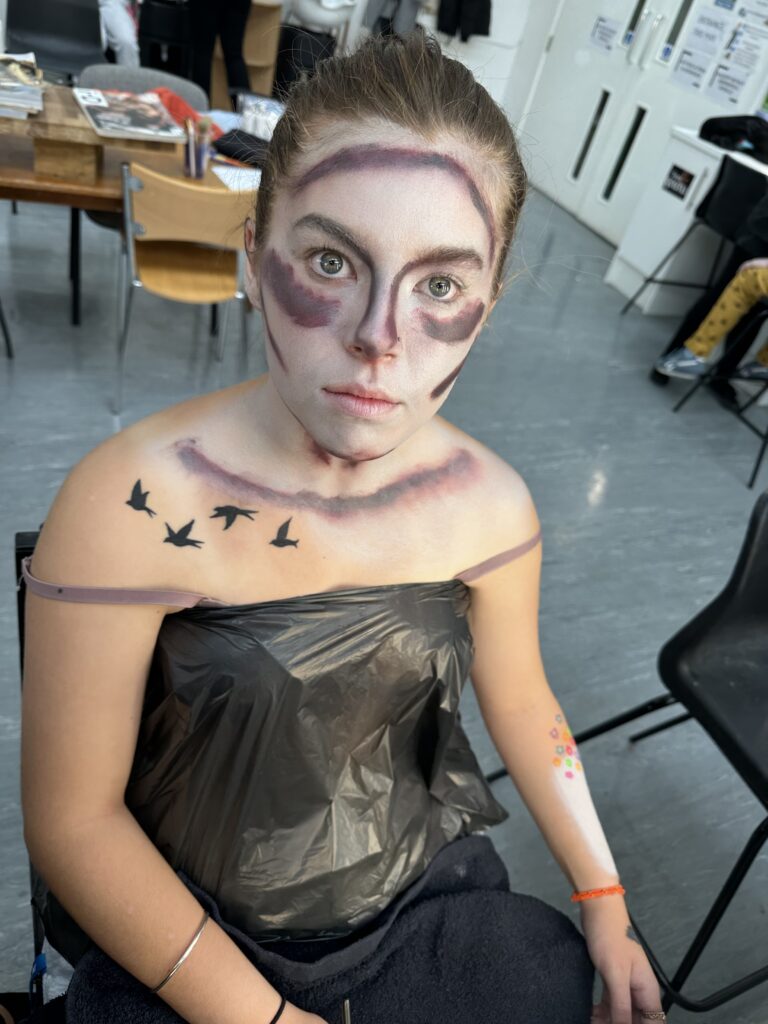
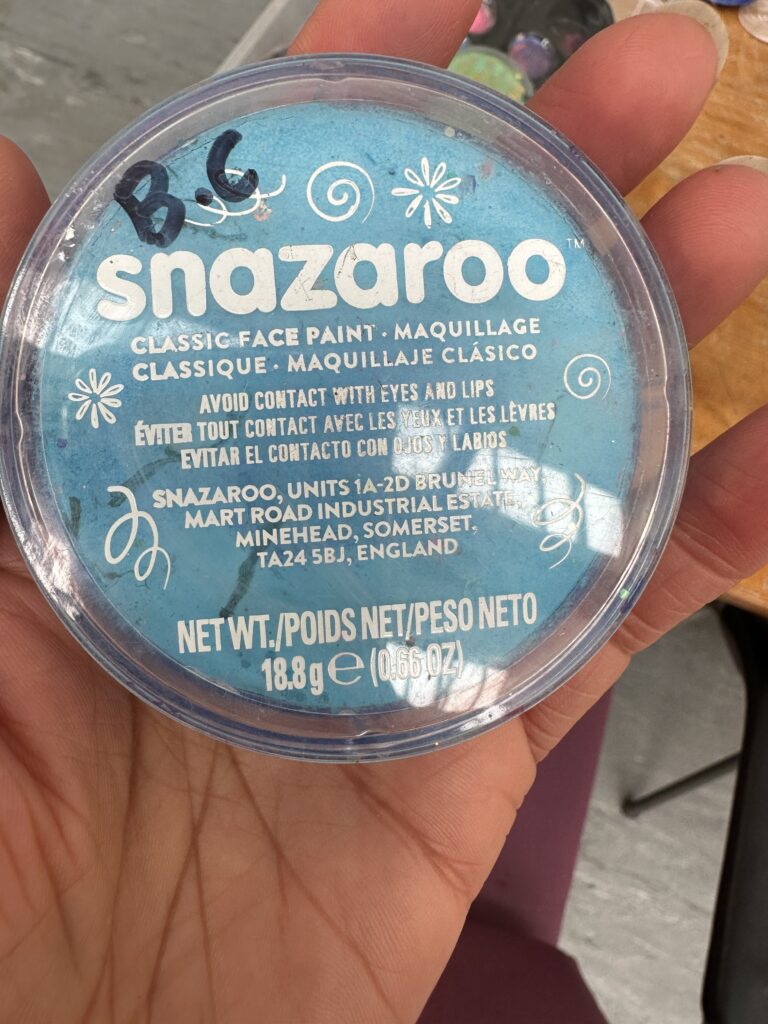
week 3 fun task
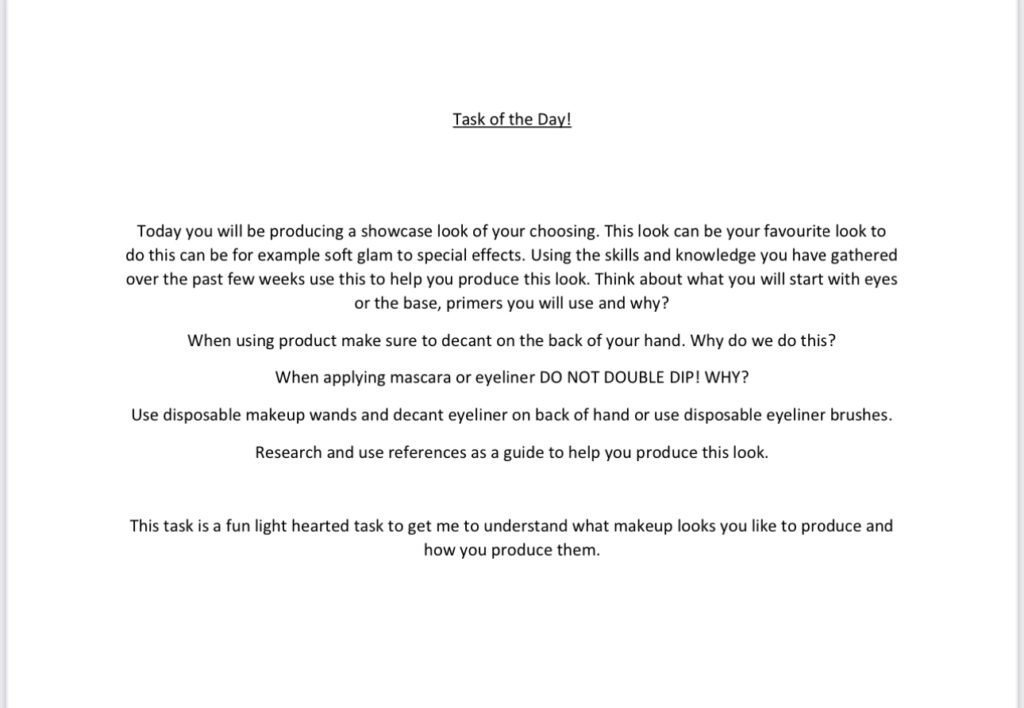
How to Prep Your Skin for All Day Makeup
- Step One: Cleanse. Before you start prepping your skin for makeup, be sure to start with clean, dry skin. …
- Step Two: Exfoliate. …
- Step Three: Tone. …
- Step Four: Moisturize. …
- Step Five: Prime. …
- Step Six: Prep Your Lips.
- start with eyes conceal, set, and colour
- we decant product on the aback of hand coz the hand will give warmth to the product which helps to apply it easily also to avoid cross contamination. must not double dip in mascara or any other product to avoid cross contaminating.
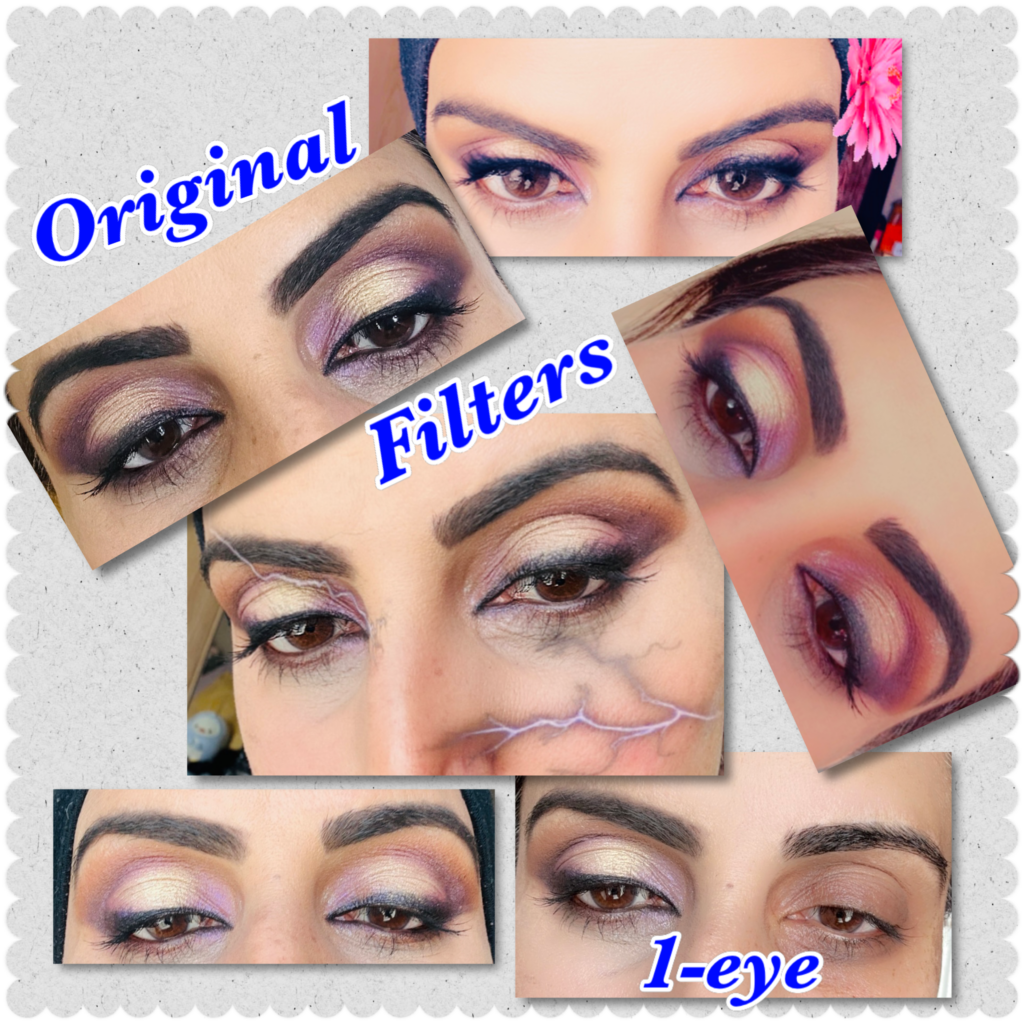
Week 4 tasks
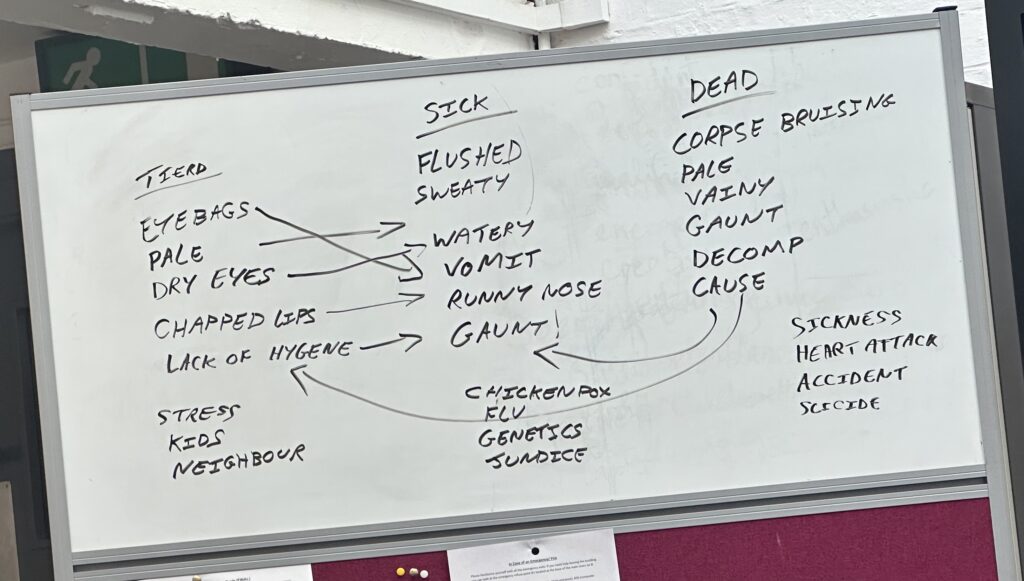

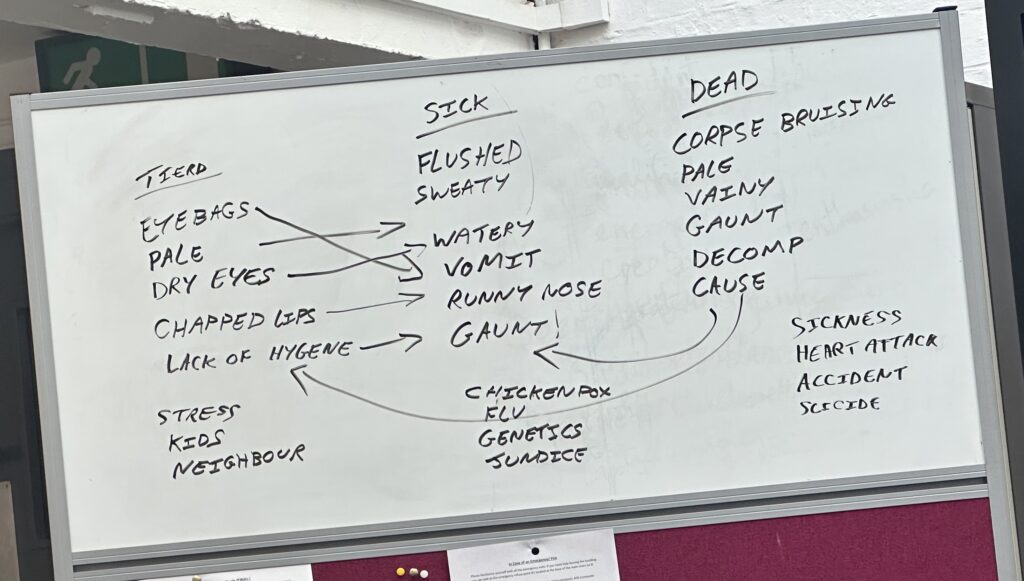
Jasmin gave us demo of tired, sick and dead look by using eye shadow mat colours one side and Bruise Wheel on other side (some liked eye shadow look/ some liked the bruise wheel effect more natural). We then had to prepare the look on our self and she effects of blending shadows to show tiredness and deadly sick look.


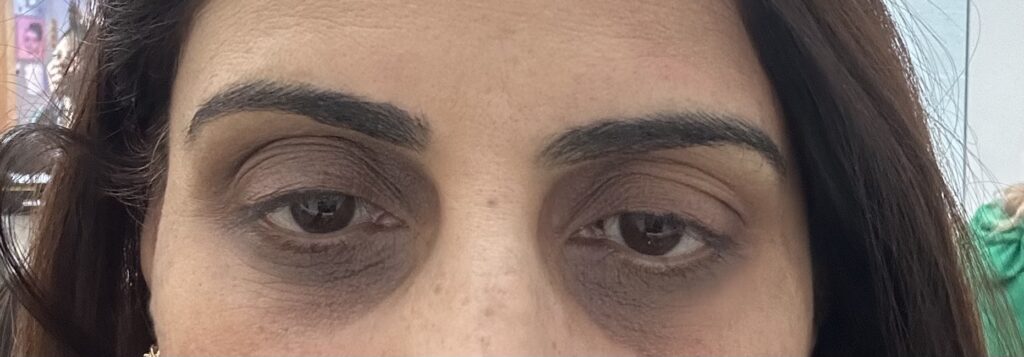
Business card design/ideas
today we looked at creating business cards ideas. Also will be selecting or creating own design and get it print out on very low cost.
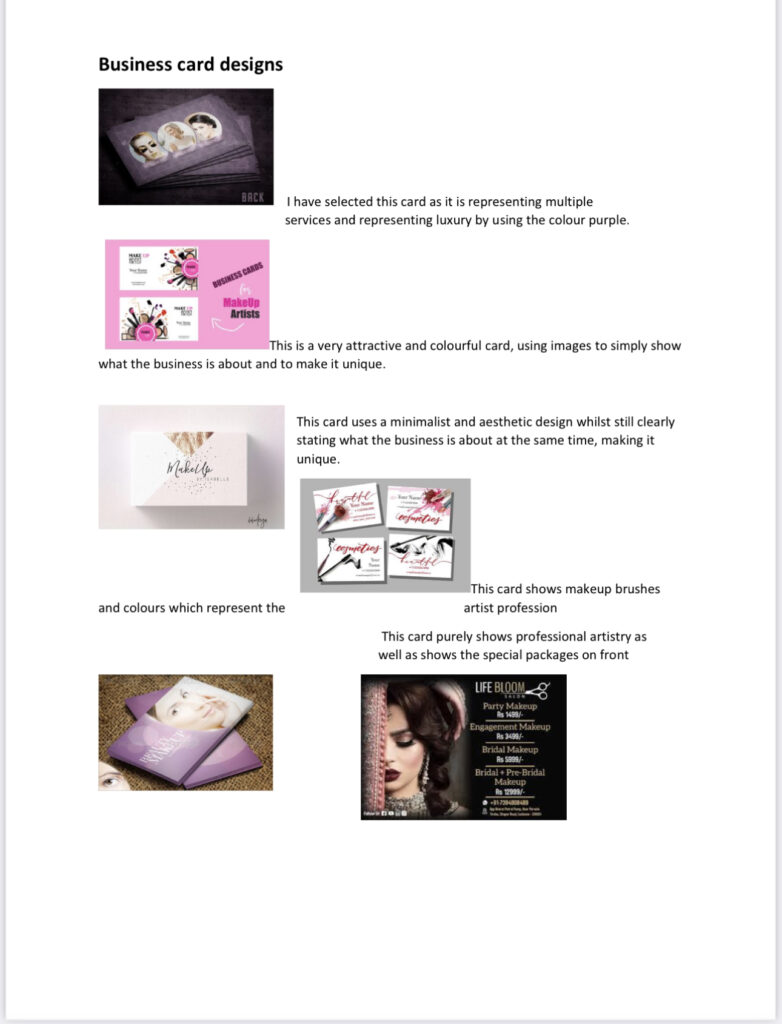
Week 5
Spider Diagram Design
today we were given a task to creat own spider diagram to describe own ideas/look by researching and showing who we got inspiration from to creat that look and why.
I have created a practice look inspired by Mazyona-Artist on instagram.
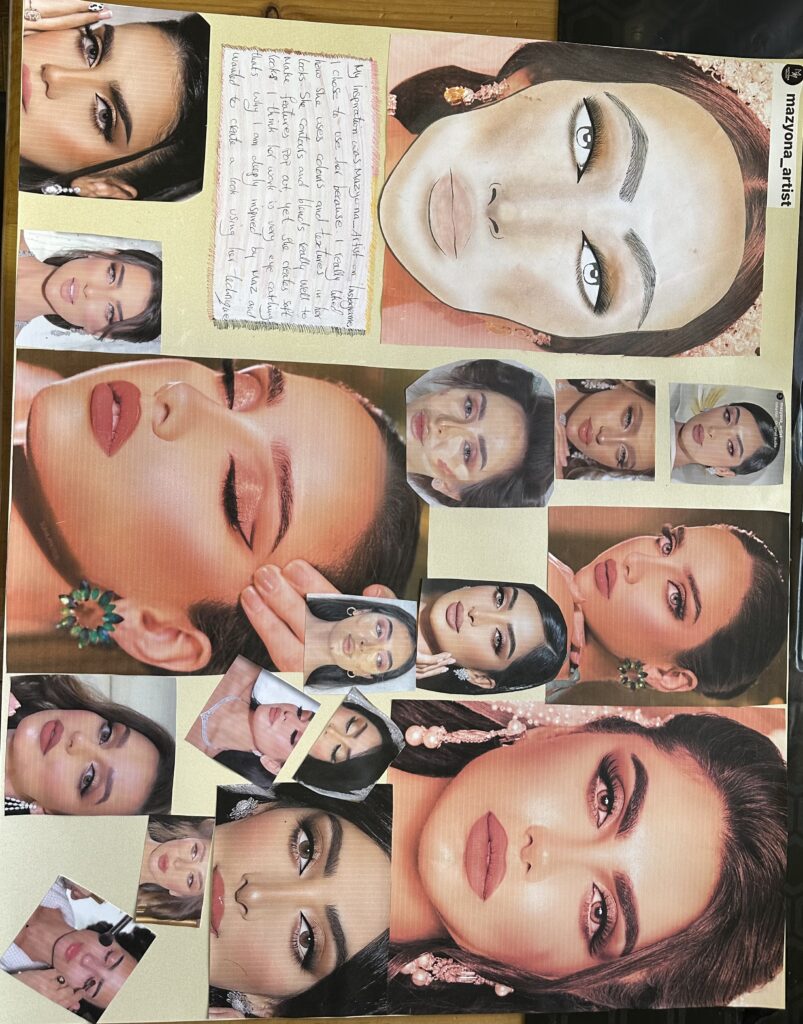
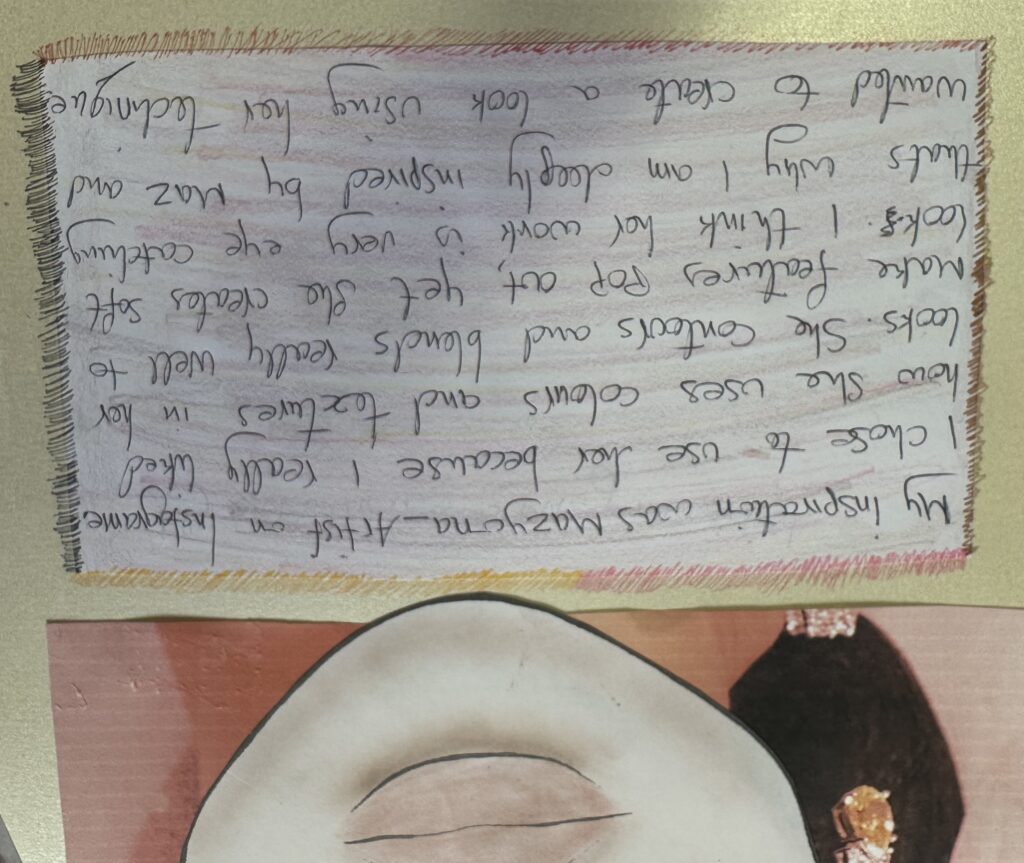

Also practised the look on each other in our lesson.
prepared my models skin by cleanse, tone snd moisturise ( normal skin type) applied primer.
I used ideas of my inspiration on Instagram.
I didn’t use colour correction as my model wanted her freckles to still show, so used 50% of each medium beige /ivory mix for the base
Light concealer, loose powder to set the base. used pink, beige, golden brown shimmer eye shadows and black eye liner. used beige contour to bring out main features, then applied pinkish blusher for softer look and silver/golden highlighter to, mid face to brighten features. black eye shadow to eye lids to darken the area, black mascara to lashes ( didn’t have eye lashes) pink/ reddish lip colour to finish applied fixing face spray.
Feed Back
thank you to Luci and Alisa for the advice and feed back on the look i created today, after inspired by Mazyona- artist on Instagram.
Tutor Luci advised if the contour lights out by the time you finish the make over, apply concealer and blend up wards for the face lift look.
Alisa advised that I should apply heave and closer eyeliner and mascara to upper under lashes so the eyes look fuller and pop out.
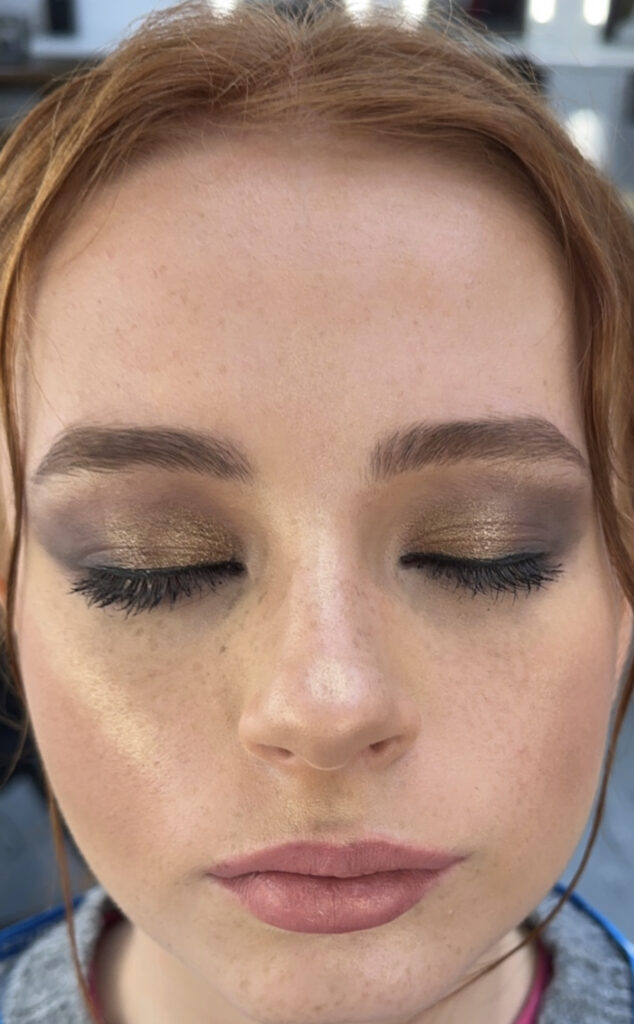



About Bradford Police Musuem
Bradford Police Museum – Museum in Bradford, Bradford – Bradford (visitbradford.com)
The Bradford Police museum is located in historical City Hall Bradford and provides an unique insight into the history of policing, criminal justice, civic enforcement and the development of crime and punishment in Bradford from the early 19th century on-wards.
The museum is situated on the site of the original 19th Century police station in City Hall which was operational between 1874 and 1974.The museum gallery covers the history of policing from the inception of the Bradford Borough Police force in 1848 right up to the present day.
Visits to the museum include guided tours of the original Victorian cells and court built in 1873 which formed part of the original police station.
Visitors can stand in the police cell that the famous escapologist Harry Houdini escaped from in the early years of the twentieth Century, and then climb up the dock steps to the beautifully preserved Victorian Court room used for filming by TV and film productions including Coronation Street.
Visit the gallery and see Victorian police truncheons, uniforms, swords, weapons, memorabilia, crime scene exhibits and unique photographs covering 150 years of policing in the city.
Much of the collection has never been seen by the public before.
View AccessAble’s Access Guide to find out about this venue’s accessibility. The guide contains detailed, accurate information which has been put together following a visit to the venue by one of AccessAble’s trained surveyors (link opens in a new window).Read Less
ANNOUNCEMENT
New Ghost Tours announced for 2022.
The Bradford Police Museum will be running the legendary Bradford Police Museum Halloween Ghost Tour on Thursday 20th October 2022. Discover the fascinating secrets within one of Bradford’s most haunted buildings. Experience a unique evening in Bradford’s Police Museum where you will gain a fascinating insight into the history of Victorian policing in the district.
This year the Bradford Police Museum has partnered with the nearby Sunbridge Wells and is delighted to be able to offer each ticket holder a voucher to the value of £5 for food and drinks at the Wallers Brewery Bar and La Caverna Pizzeria. Details will be given on booking.
To book tickets for our ghost tours go to our events page
Museum Opening 2022.
The museum is open throughout 2022 every Friday and Saturday until the end of November. We have extended our opening hours so that we are now open from 10am to 4pm both days
All our volunteers welcome you to the museum which has been named as one of Bradford’s top ten visitor attractions by Trip Advisor.
Please all be aware that you can now pre-book and purchase tour tickets in advance of your visit by clicking the tickets link below and we strongly advise you to do so. Whilst you may still come down on the day and go on a tour, booking in advance guarantees your visit particularly at times when we are busy.
The safety and comfort of you and your family is our top priority. Please read our ‘before your visit page’ on this web site prior to booking your tickets and coming to visit. It contains essential information that we you will need to know.
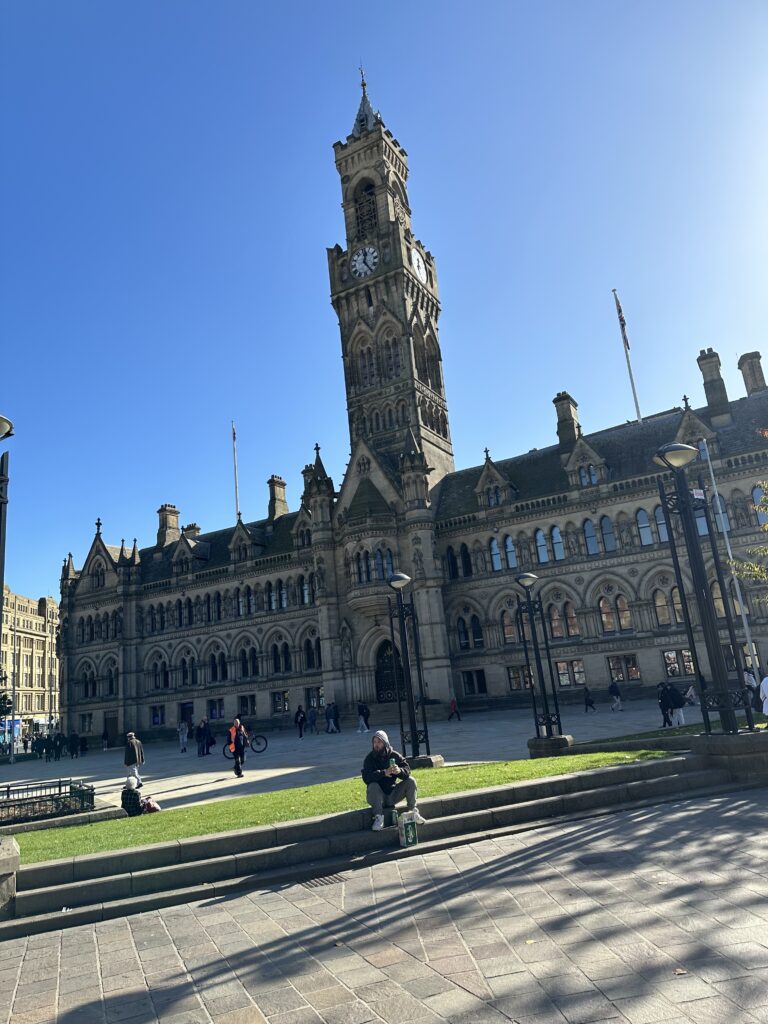
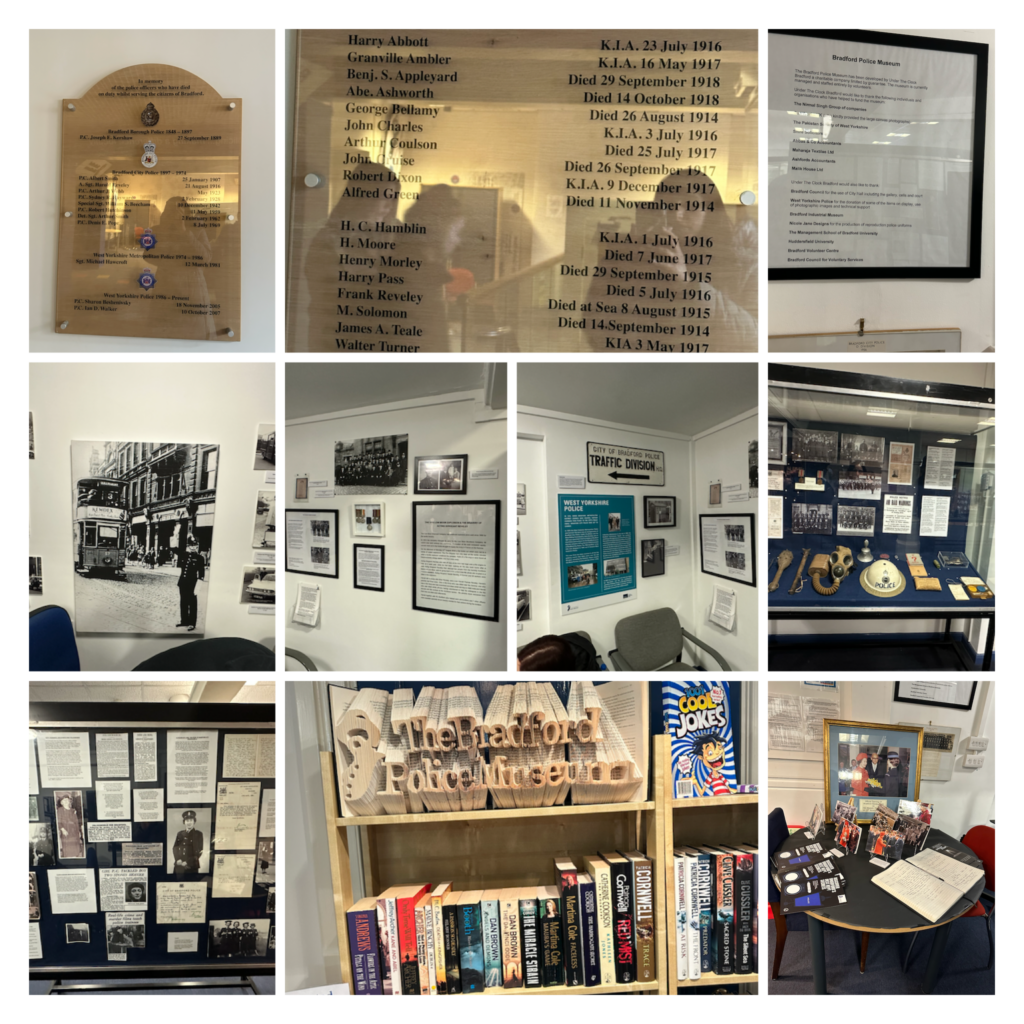

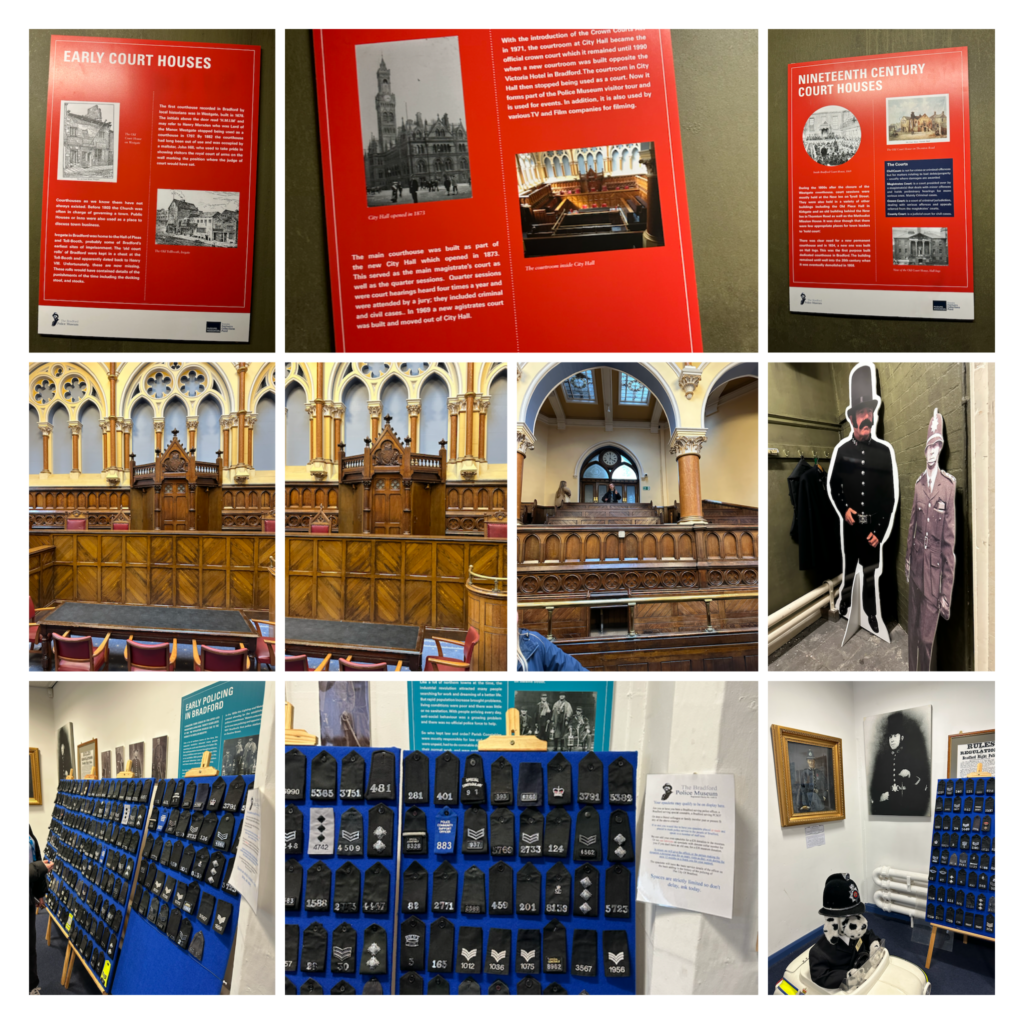
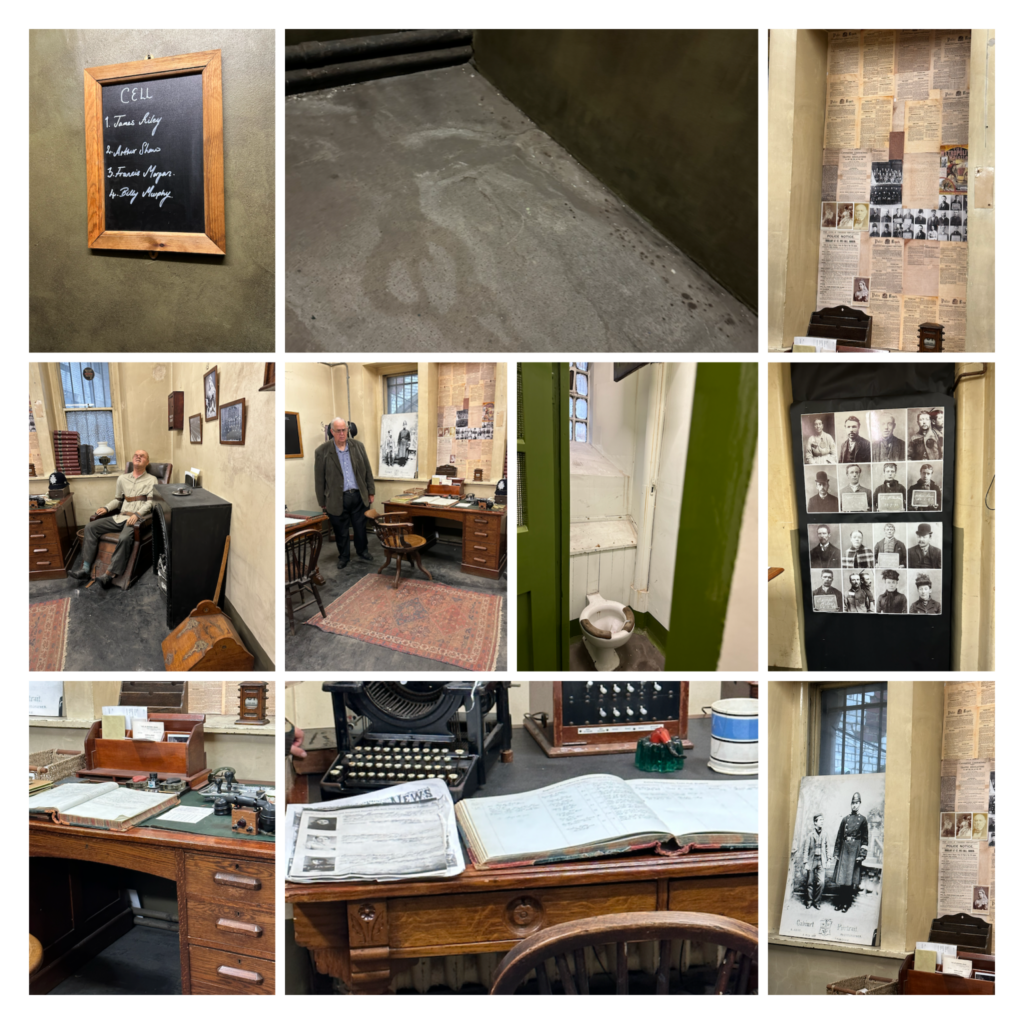

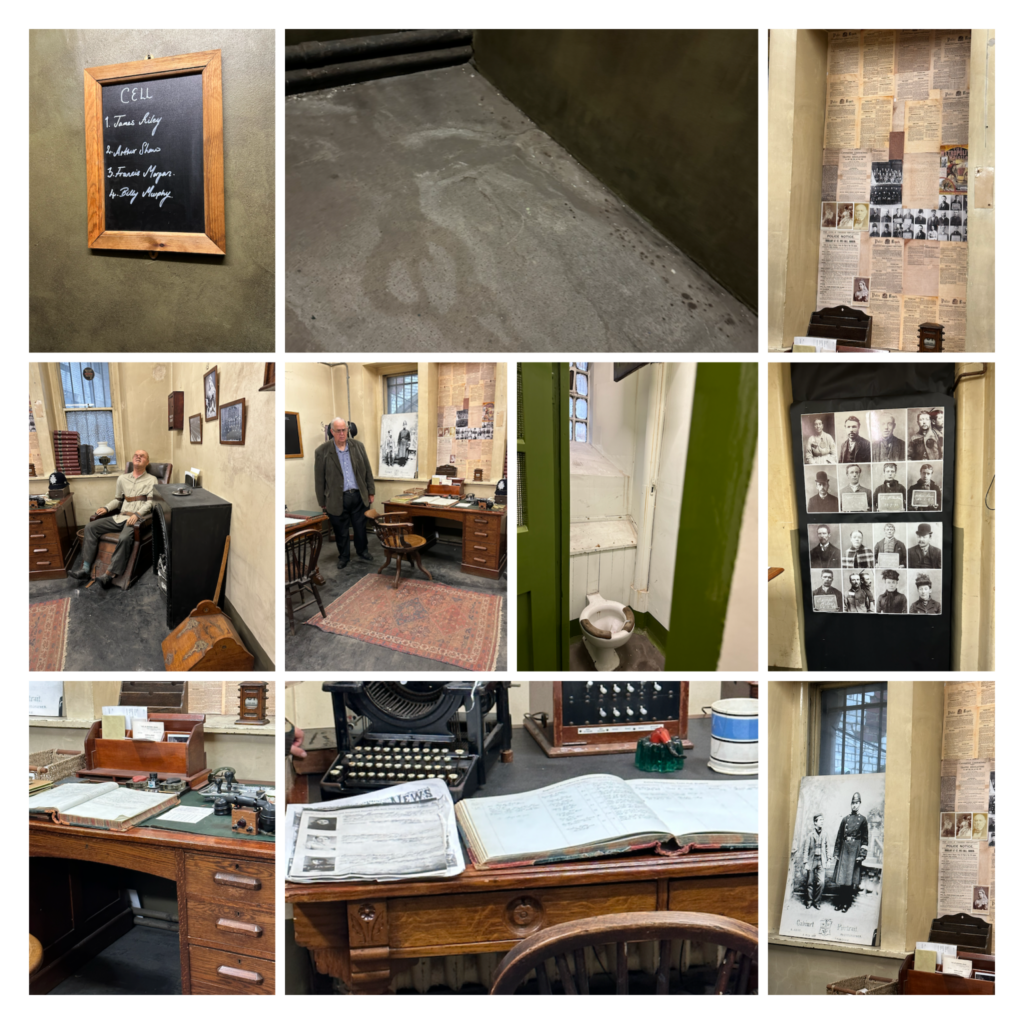
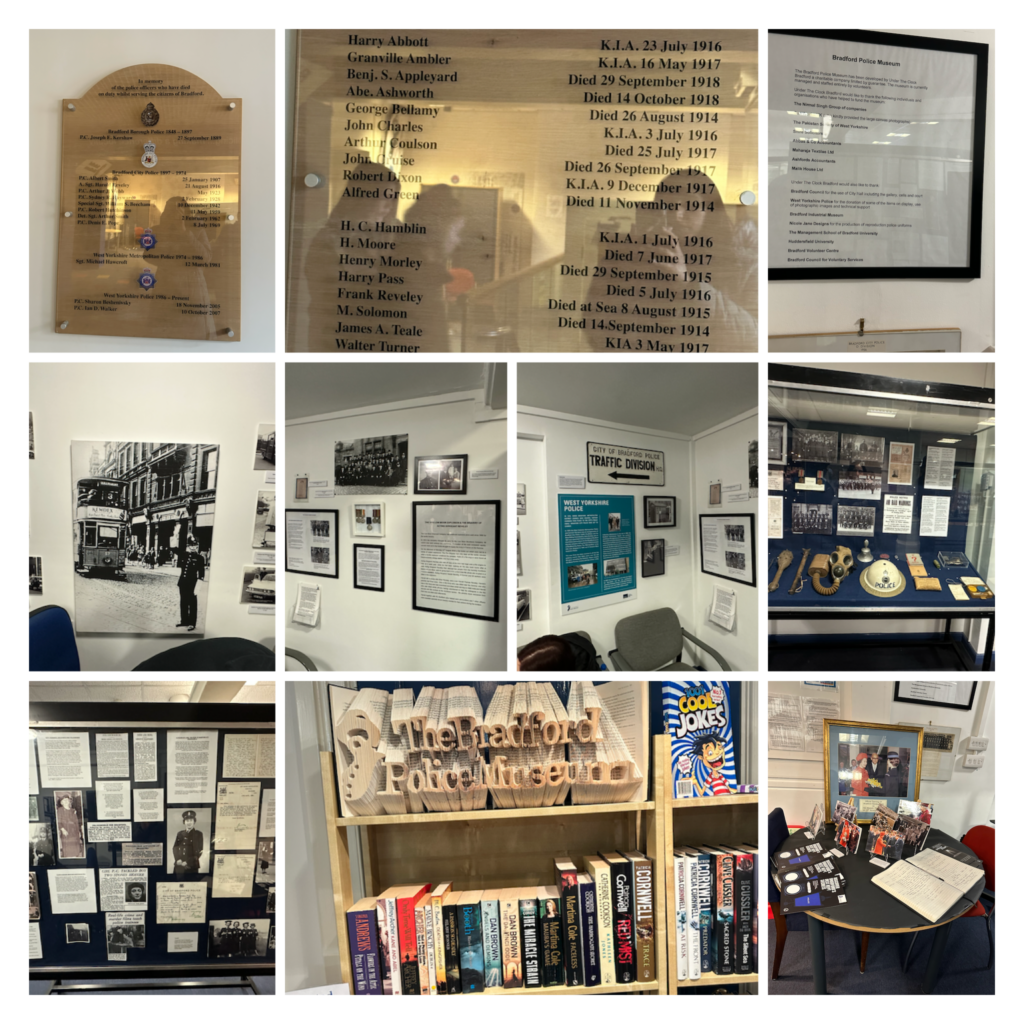
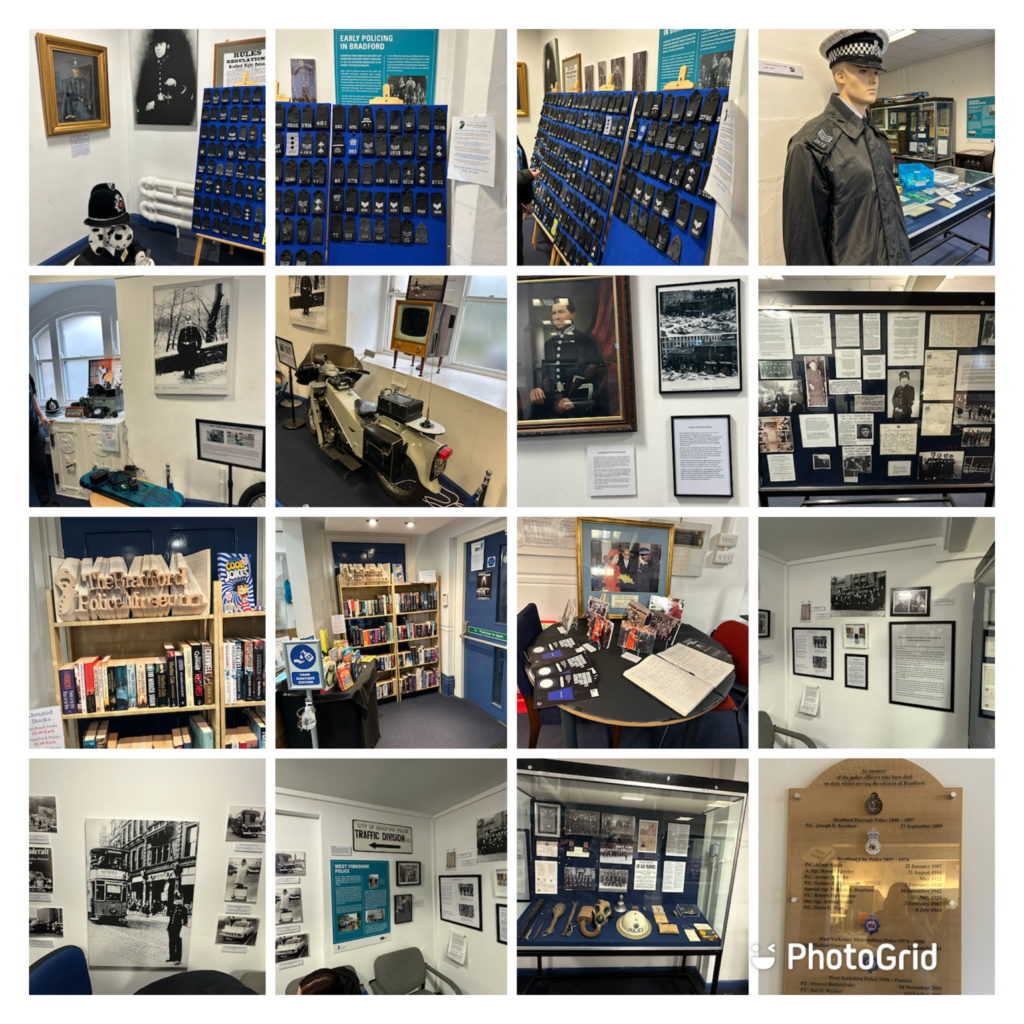
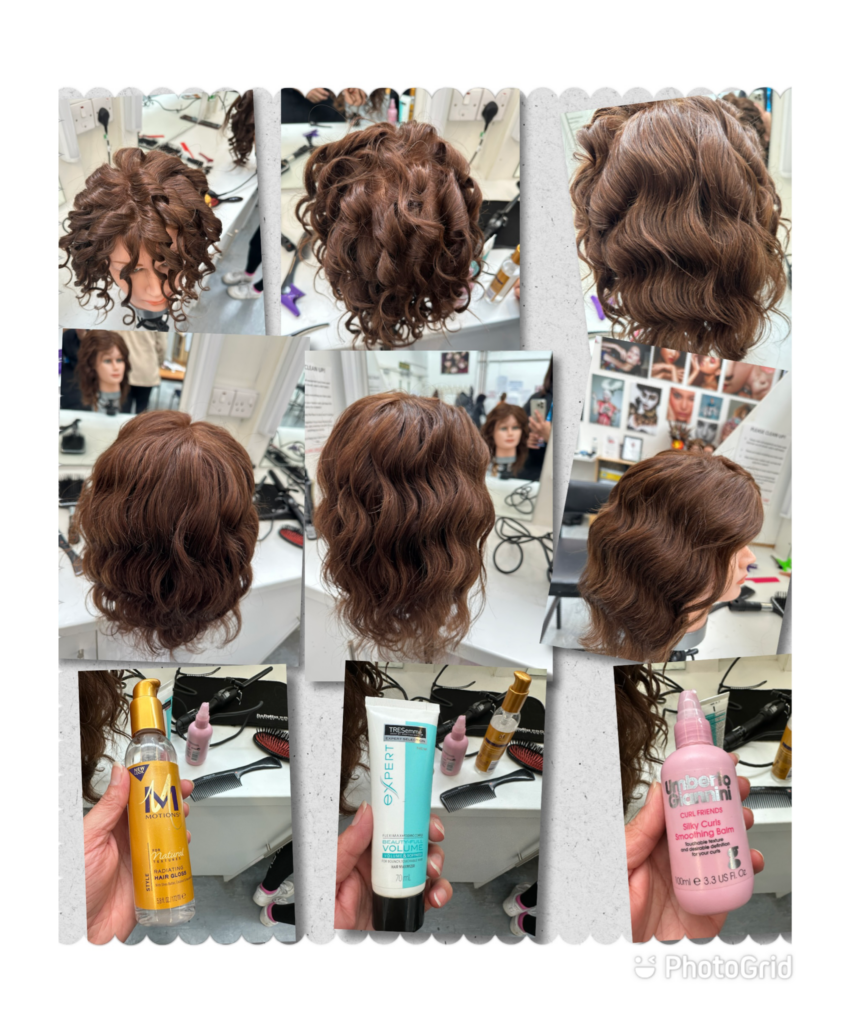
My first look of Halloween makeup
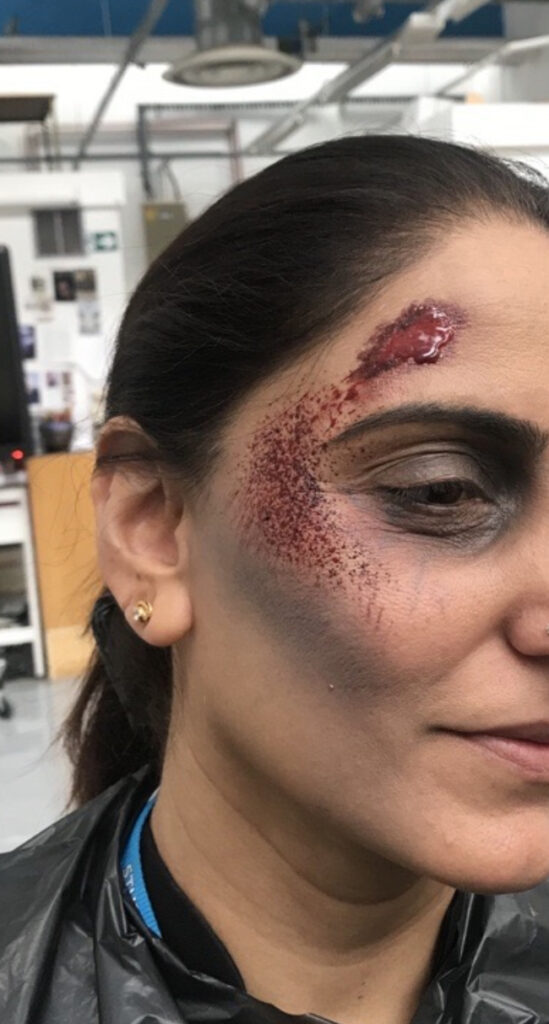
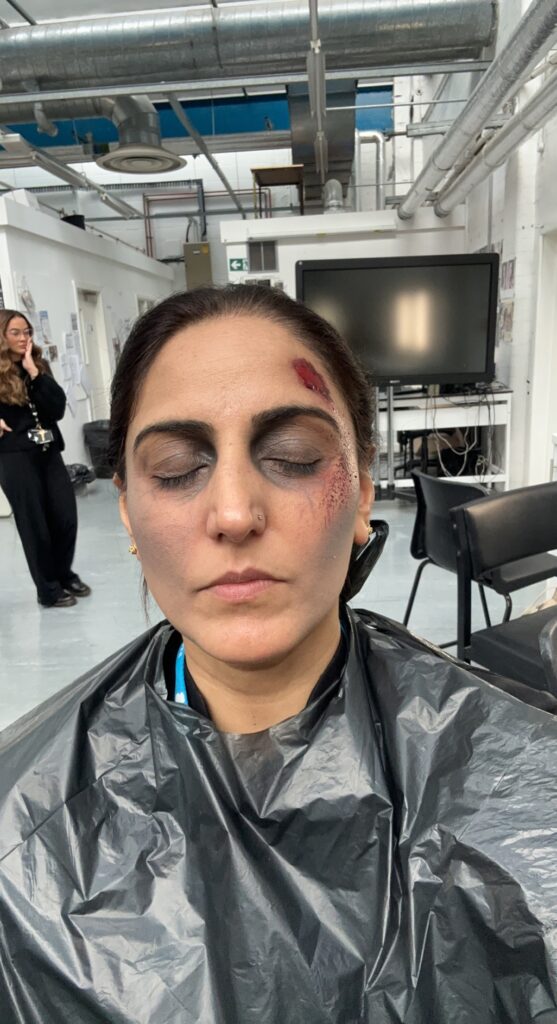
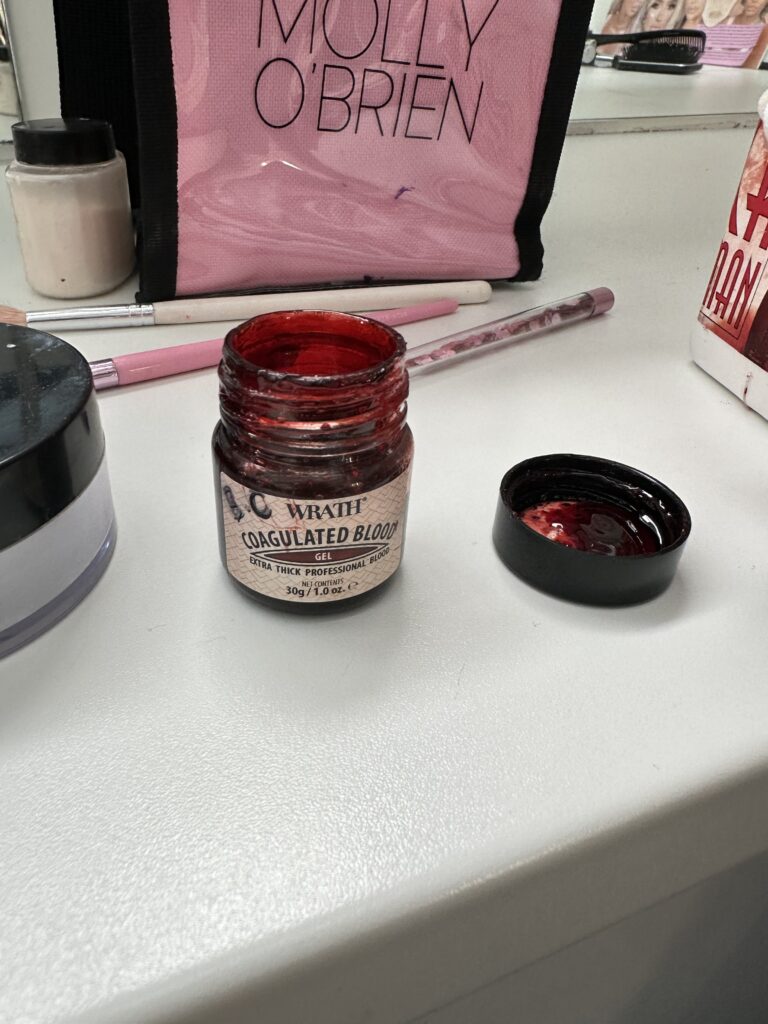

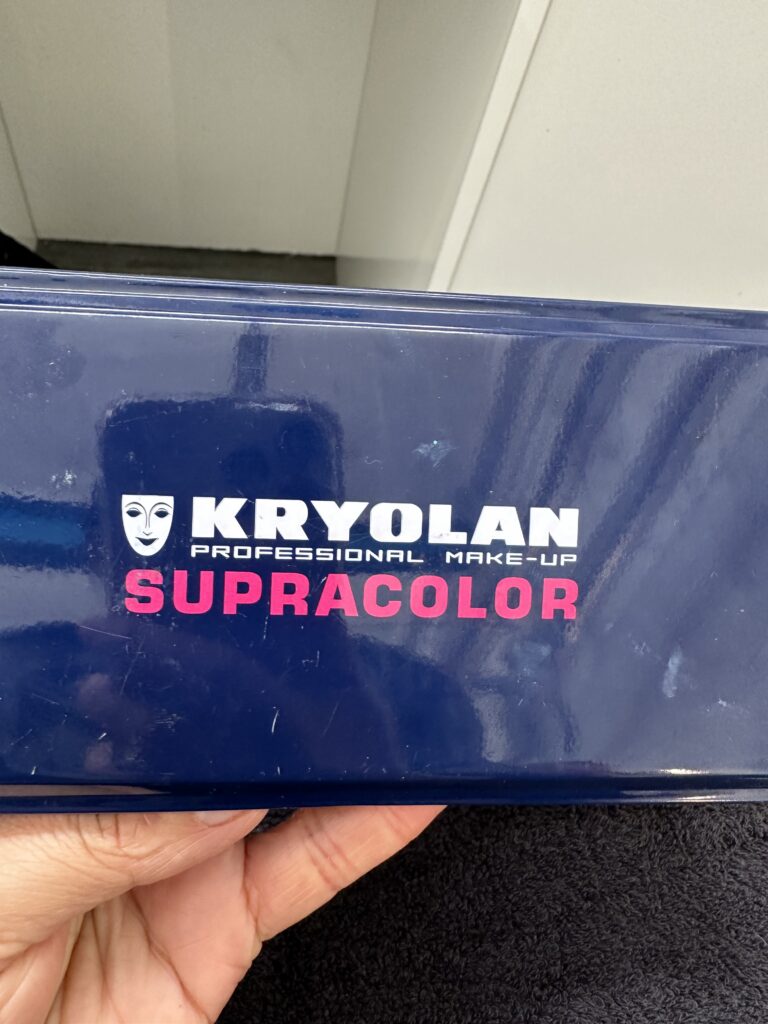
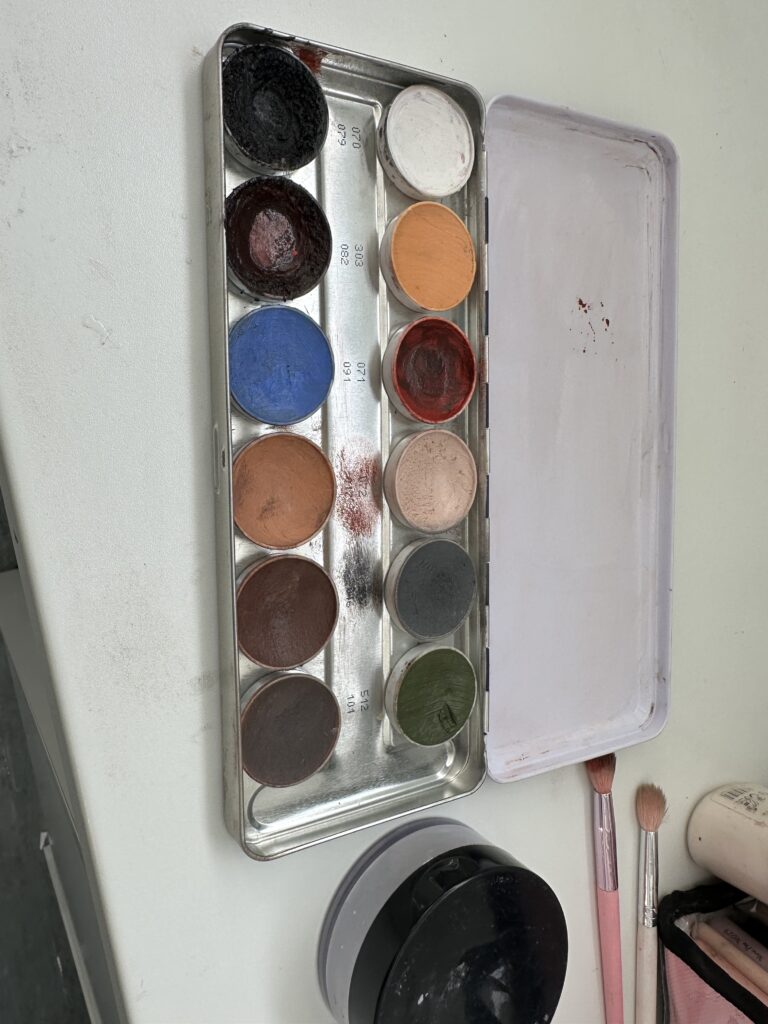

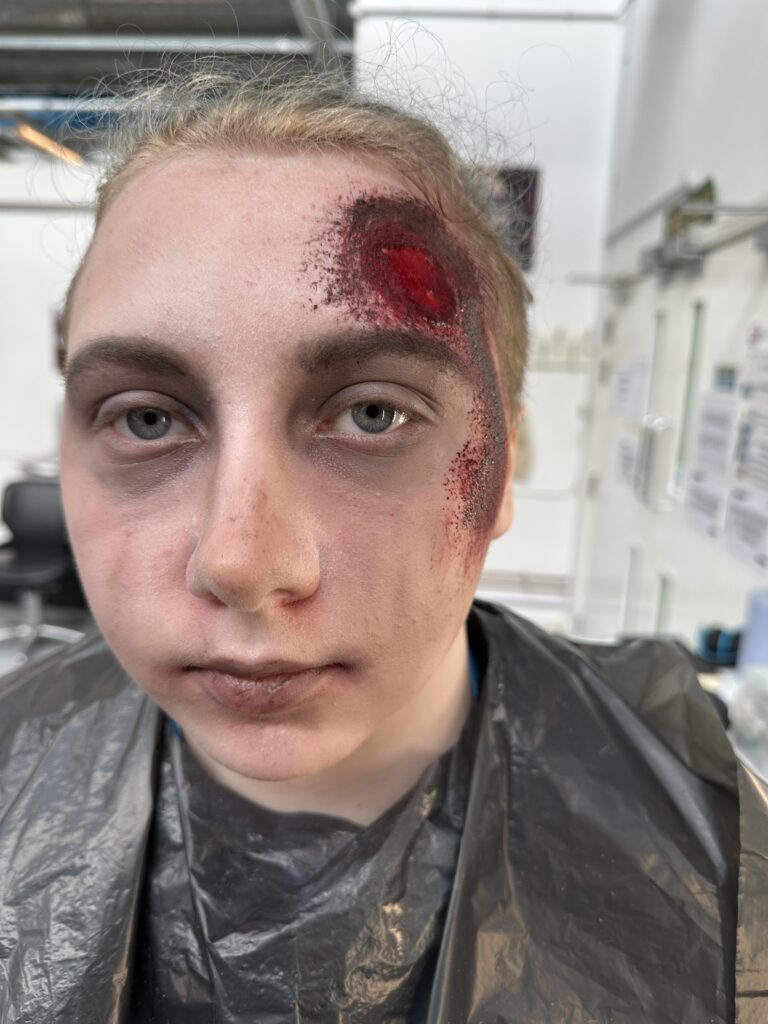
Second look from base to after special effects applied
Feed back from student
Holly didn’t remove her make up and went home with it on, many people on her way stopped her and asked if she was ok and if she needed an ambulance. so she explained it was make over from the prosthetic course she is doing at BD College!
Week 6
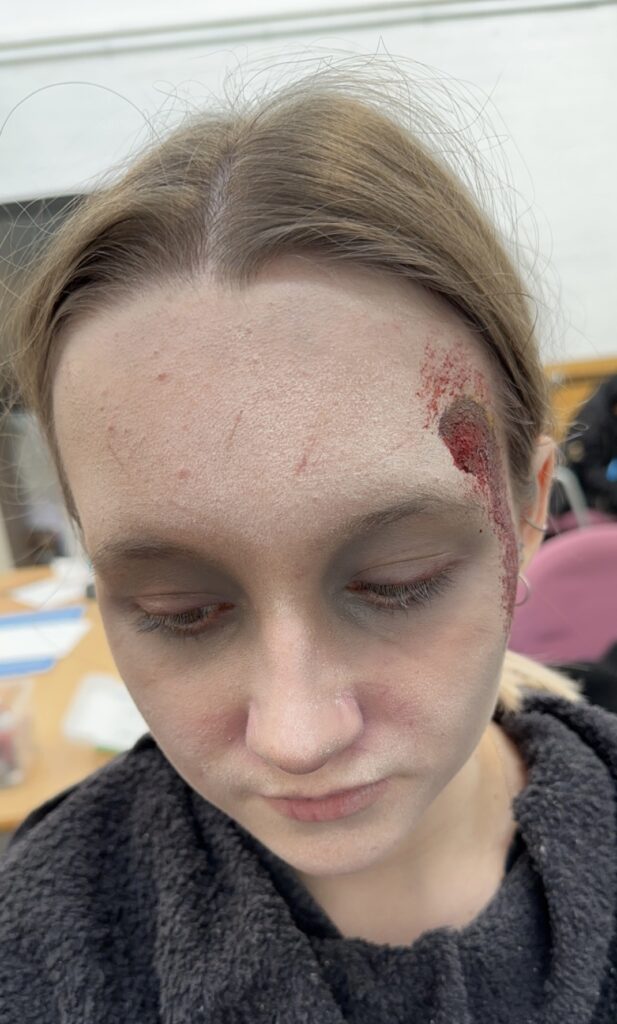
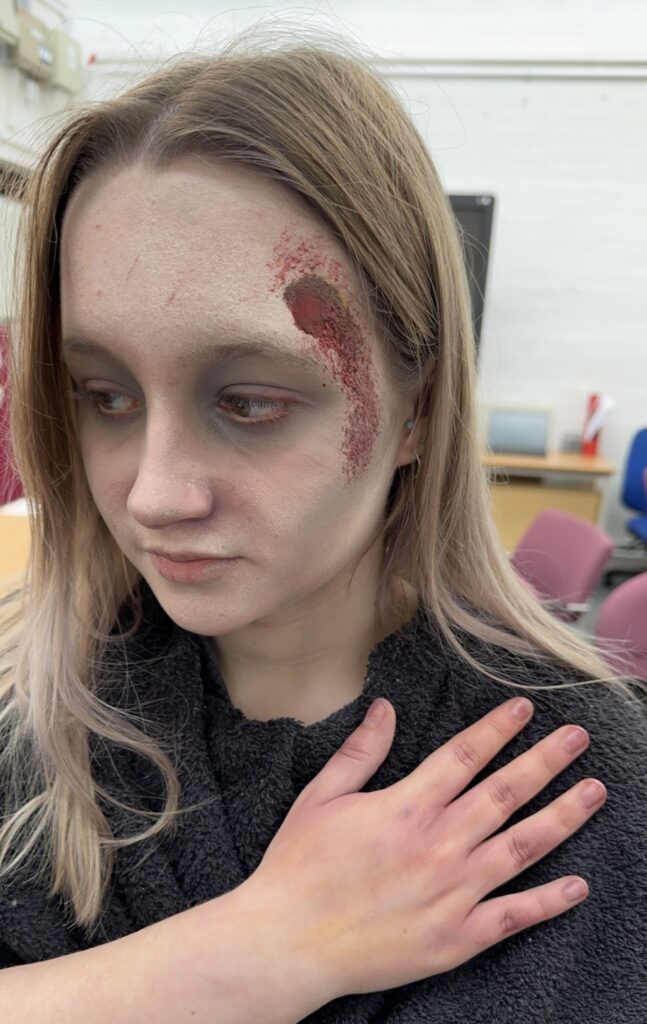
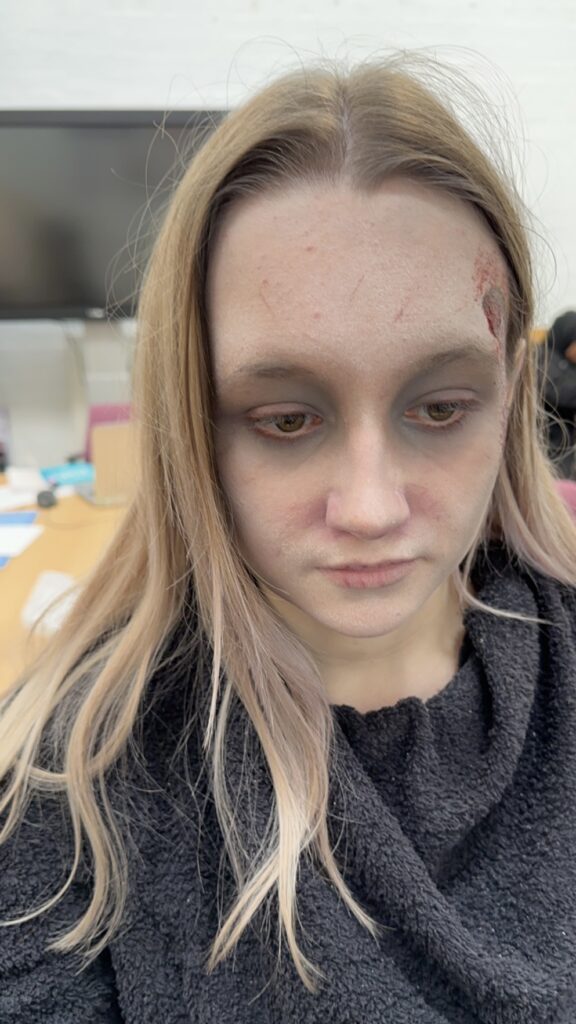
I am happy with the third look as I have covered the hands too using cream base brown, red, yellow and blue to make it look dirty and sore, which makes the whole look much near to look realistic. used KRYLAN supracolor, Standard washable blood, and WRATH-Coagulated Blood Gel, to create the wound and scaring.
Practice on real characters and their role
Rose’s character is Bertha, girl who stole milk and got caught by the police, her case was presented in the court of judge Smith, by whom she is was found guilty of stealing milk and was ordered Death by hanging.
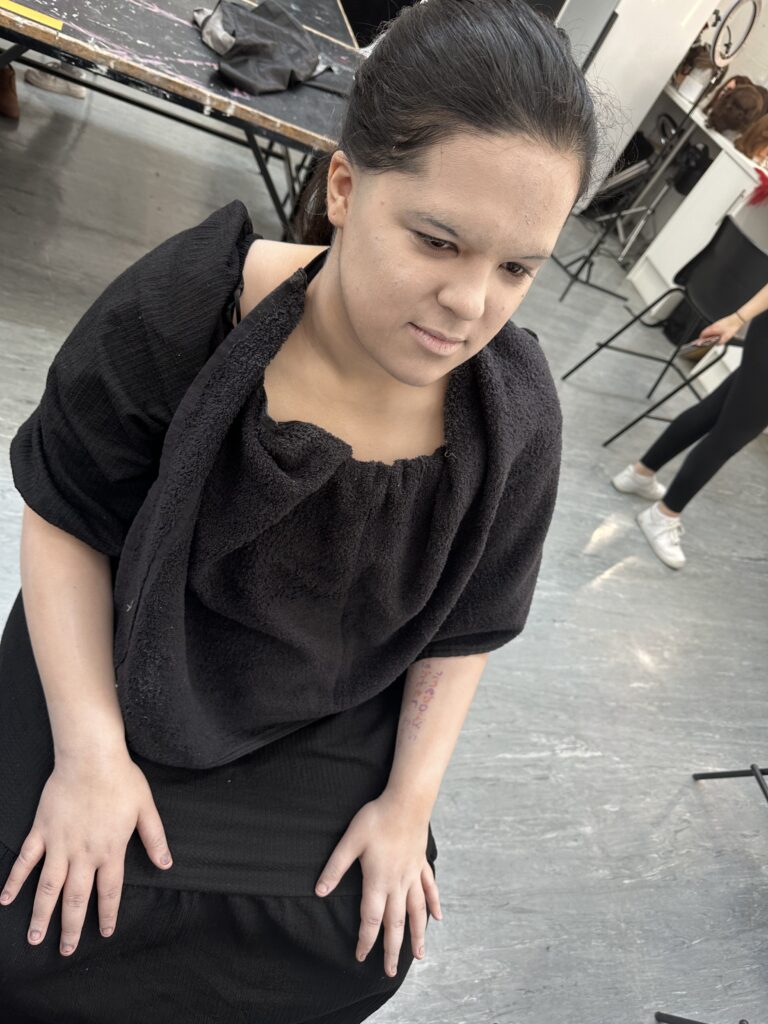
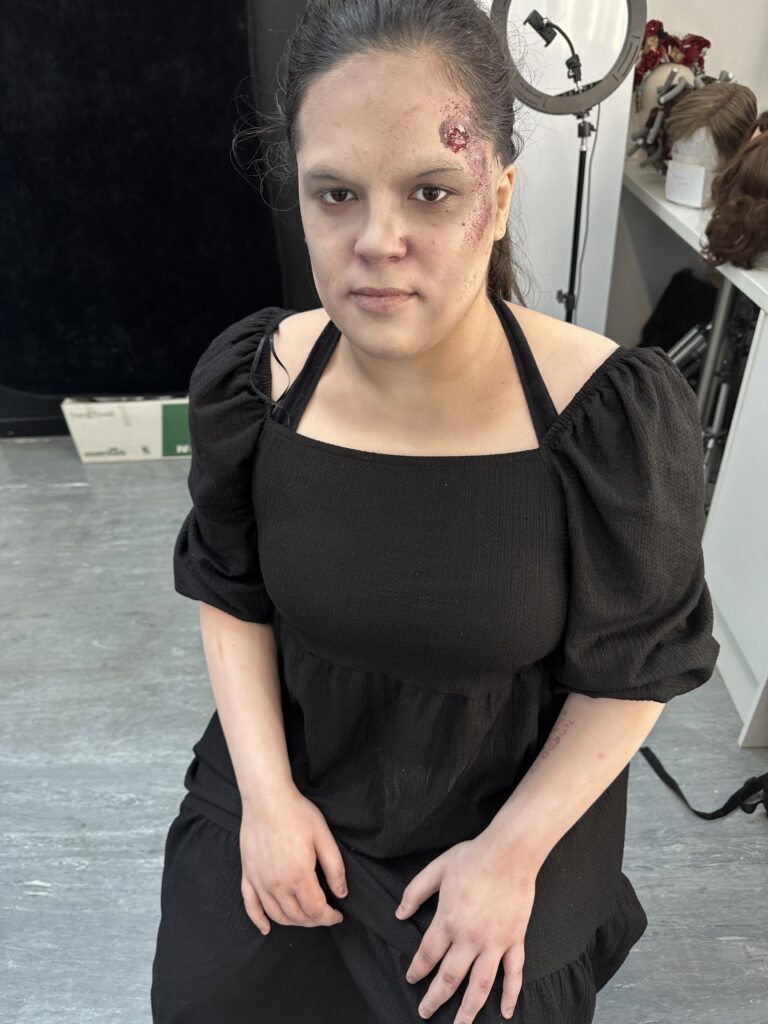
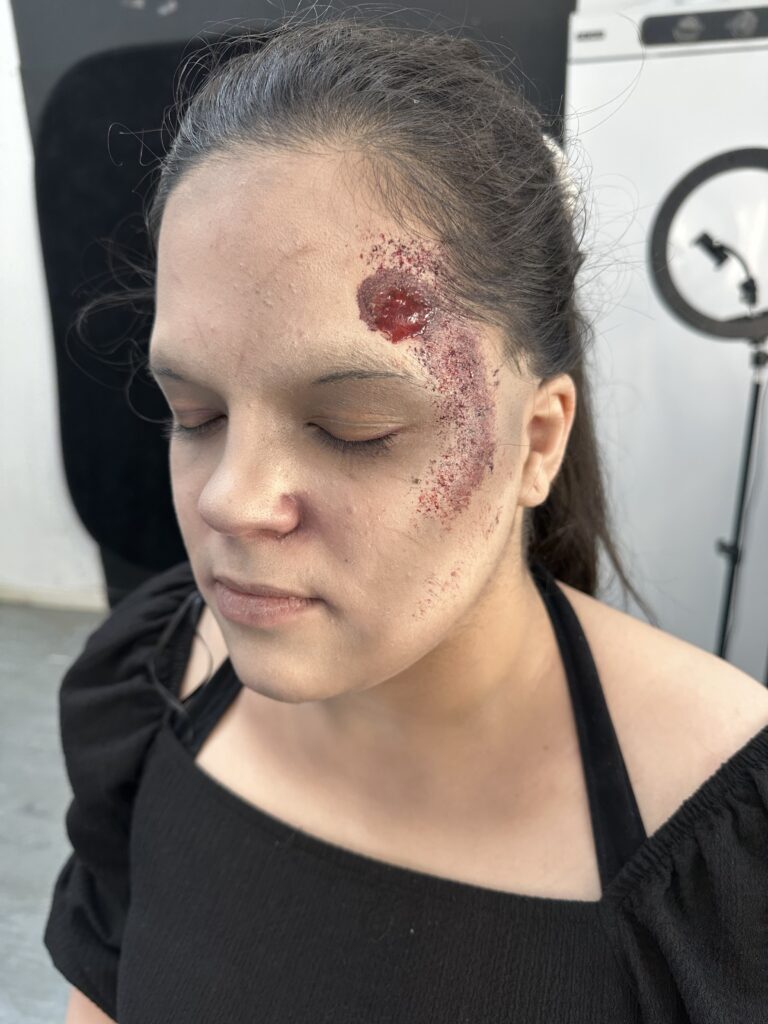
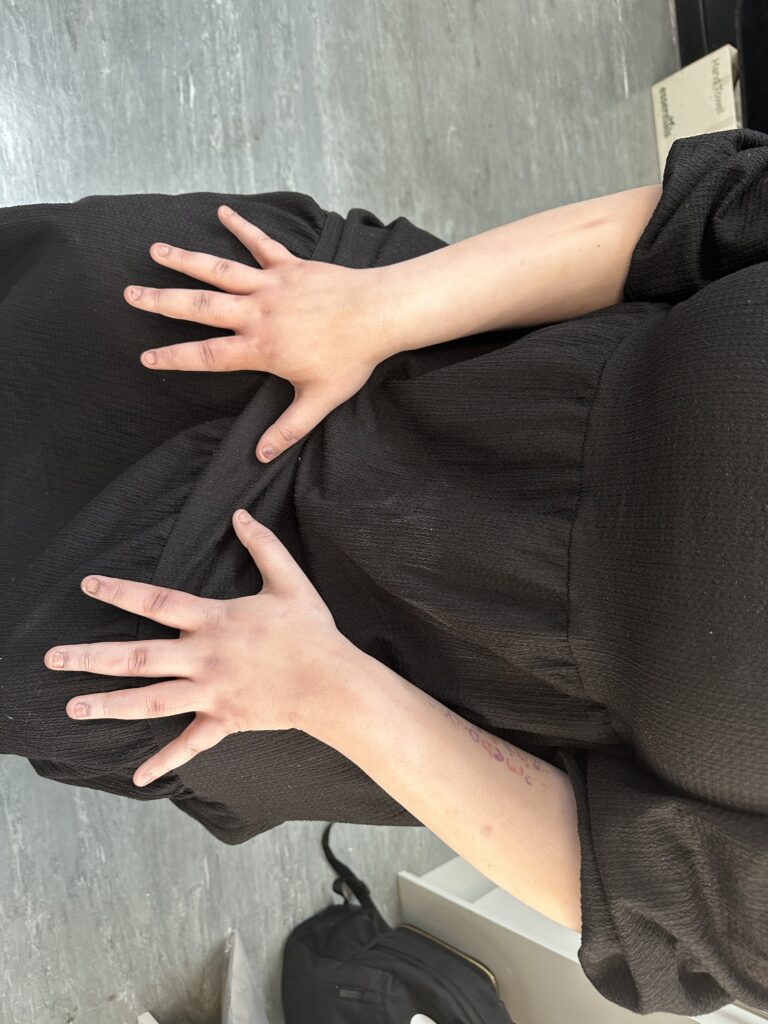
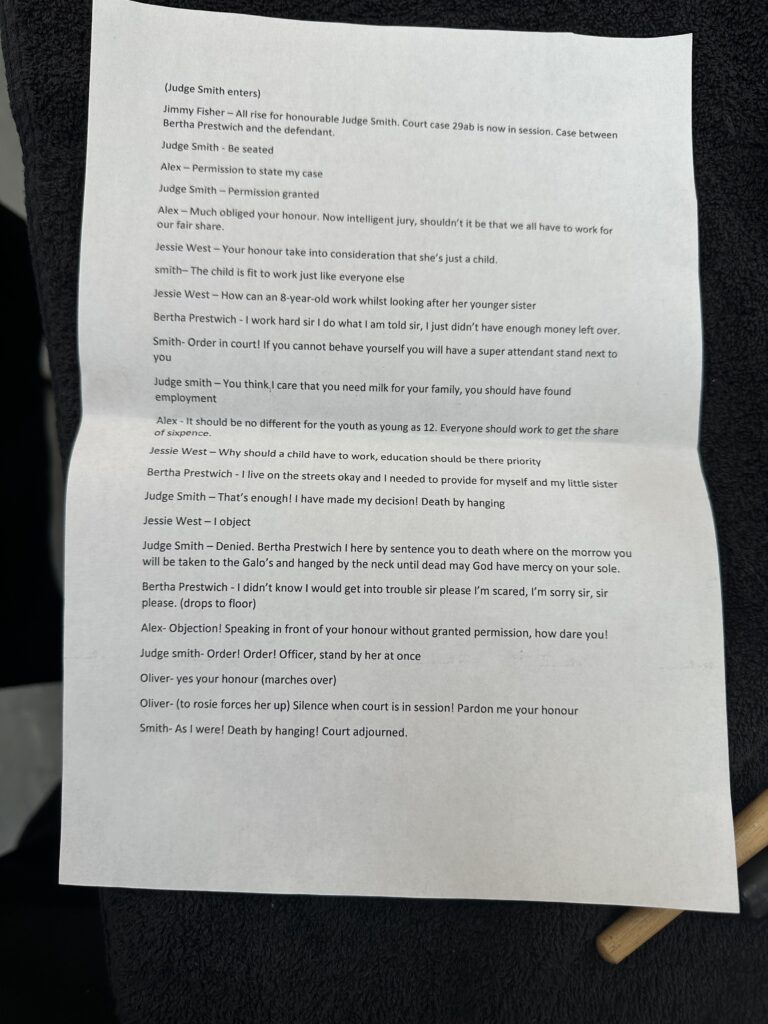
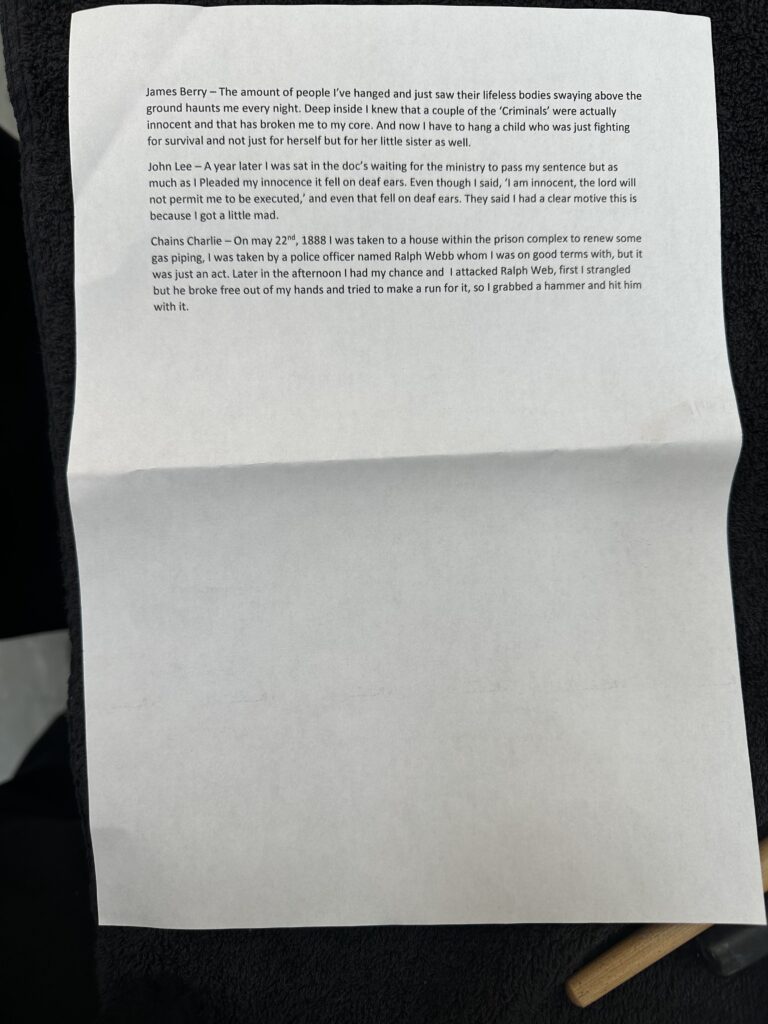
today I have practiced the Halloween look on Rose and she has given the script copy of which she will act in the court on the performance day.
additional character makeup
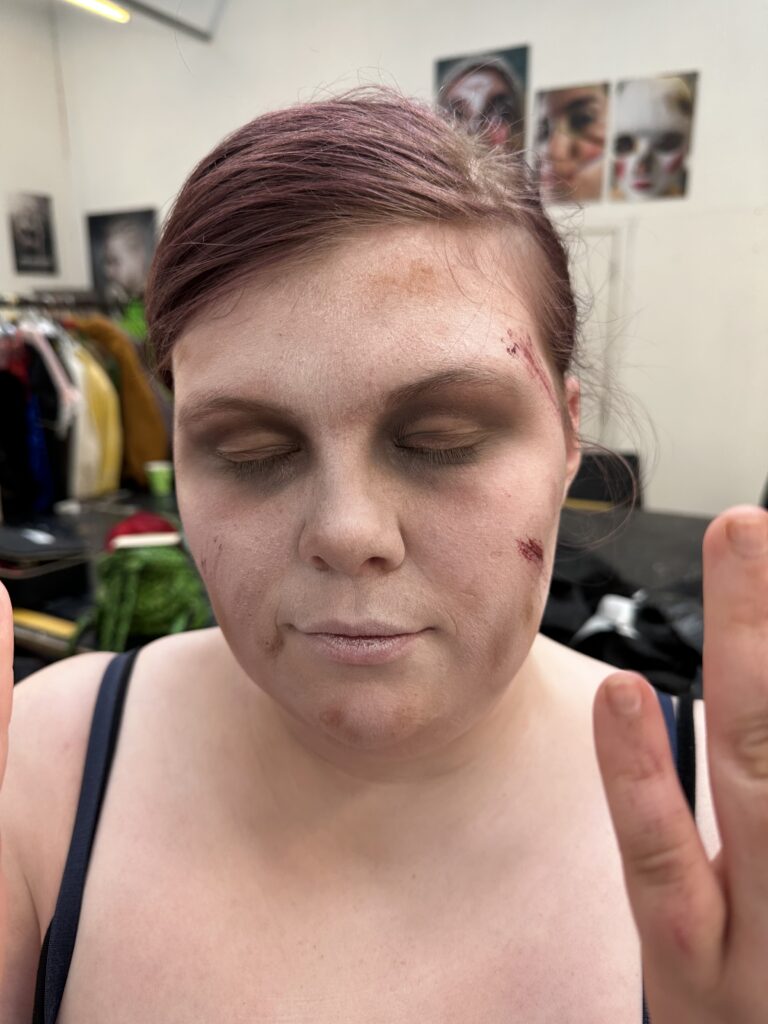
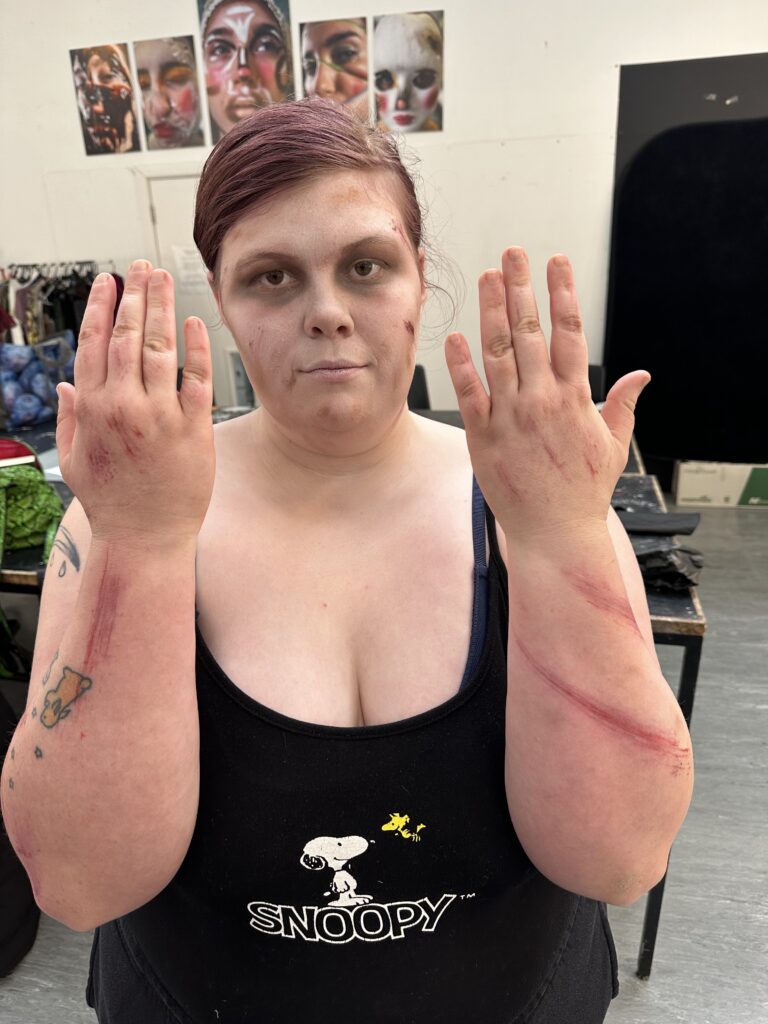
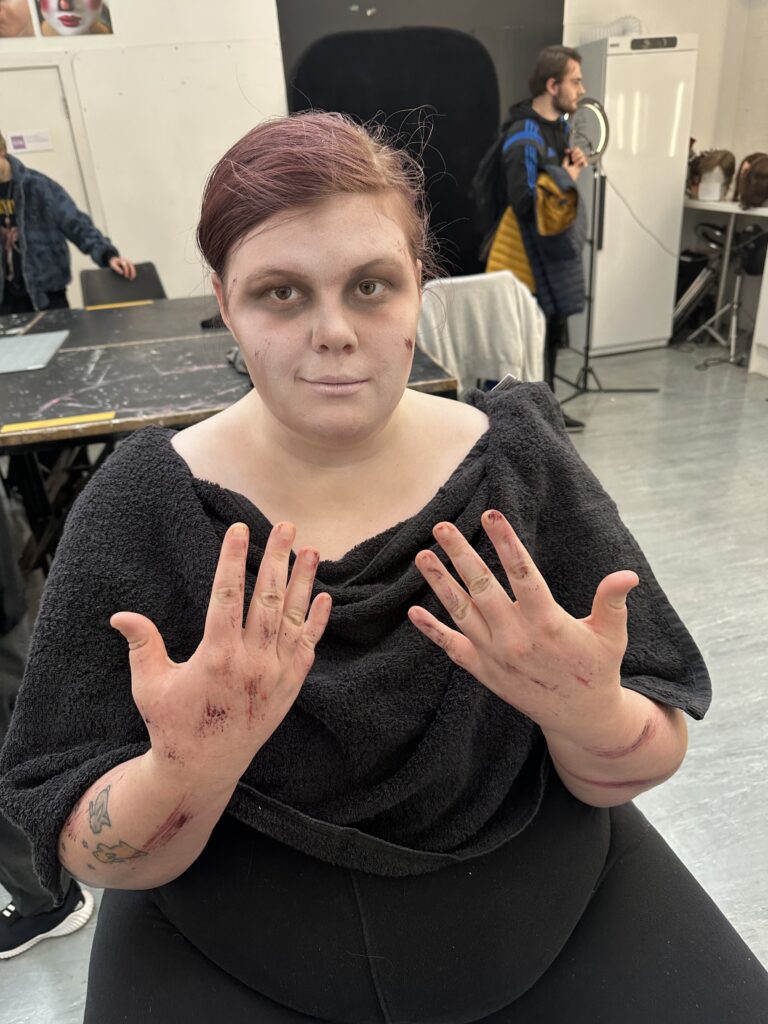
This is additional character (Chelsea) as an old man who was a gardener in later life, but was called John Lee. He was framed for murder at his mistress’ house in babacombe bay Devonshire. He was sentenced to death by hanging. He had a dream where the trapdoor to the gallows would fail and it did the first time so they took him off and tried a sandbag and it worked they repeated it a second time then called a carpenter and a woodsmith to see if anything was wrong they tried a third time and failed. They sent him back to his sell with a life sentence.
Feedback from my model
Chelsea’s mum really loved the blending of the make up and thought it really looked professional. She was very happy.
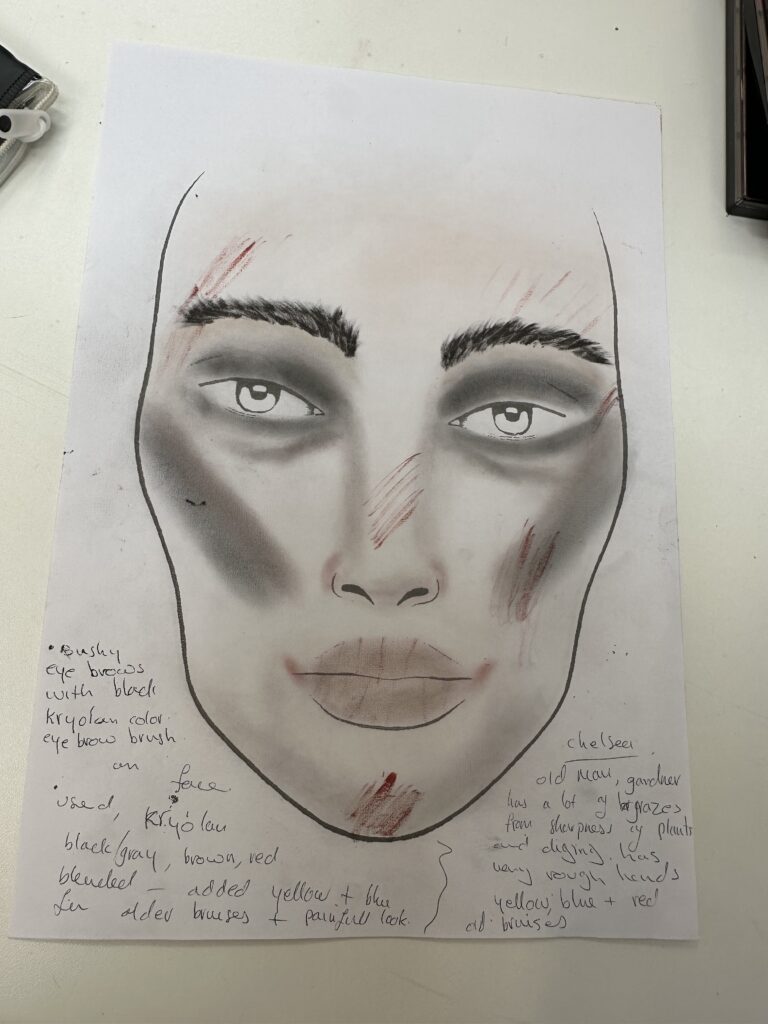
This character has sunk in eyes, had really rough hands, cuts and grazes all over face, hands and arms. who has have bushy eyes, which I forgot to do on this look as it was done in rush, but on the performance day i will make the eyebrows bushy and rough as well as the hair.
Week 6
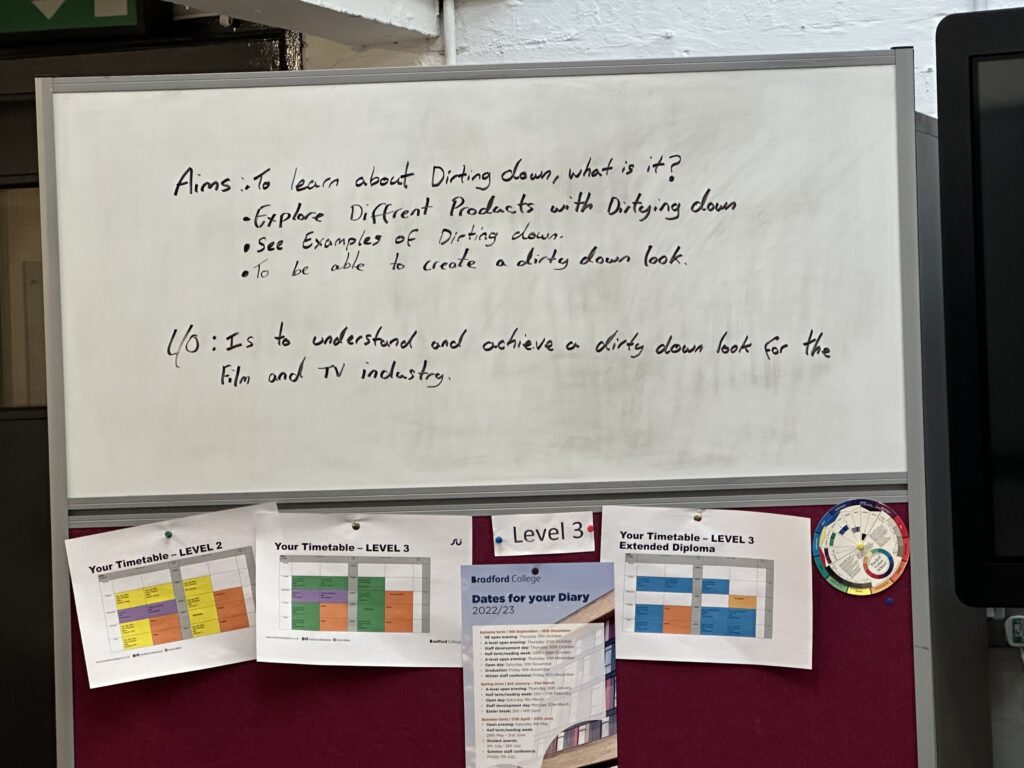

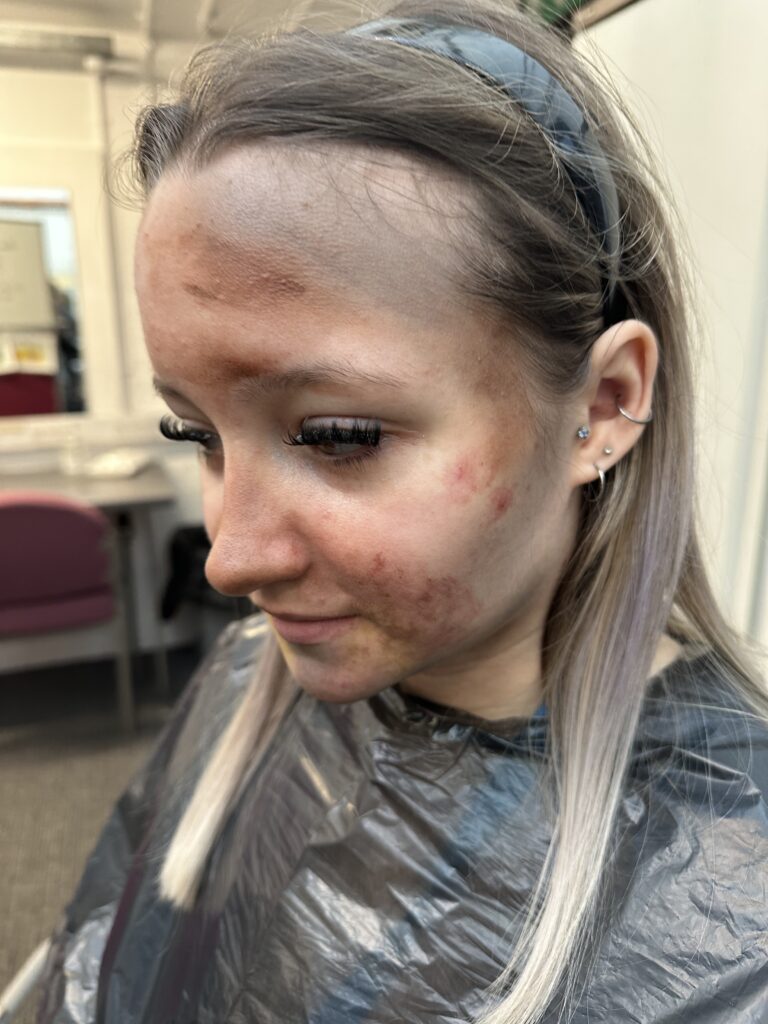
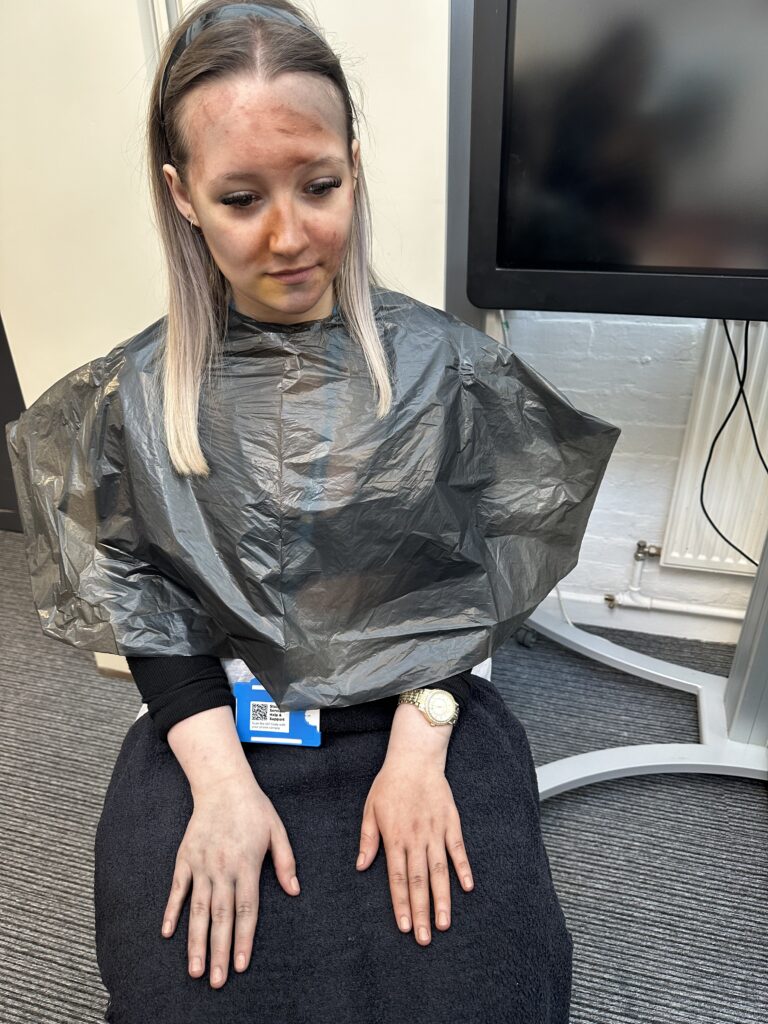

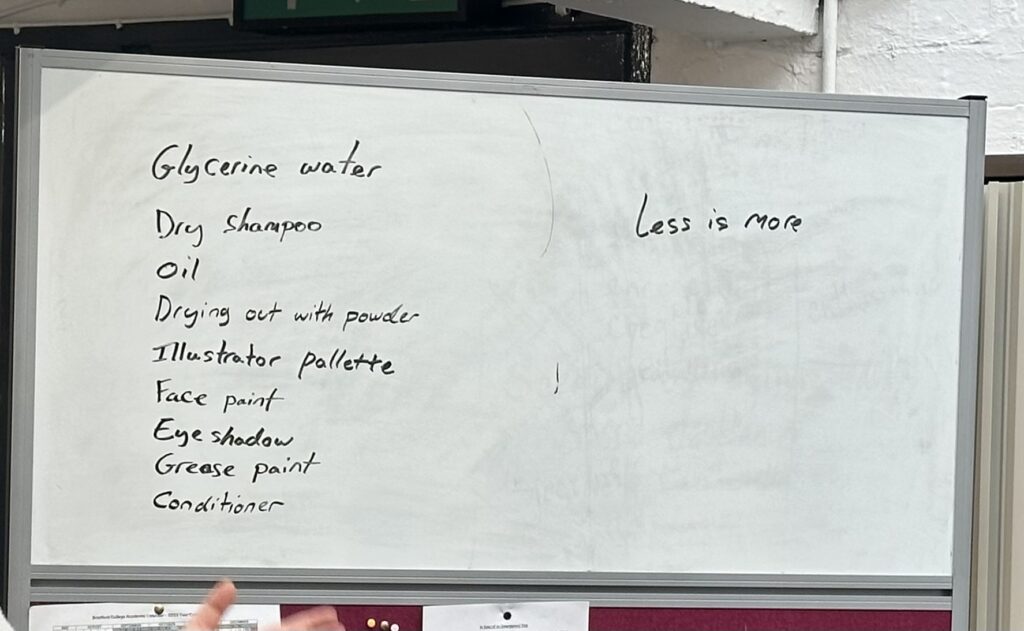
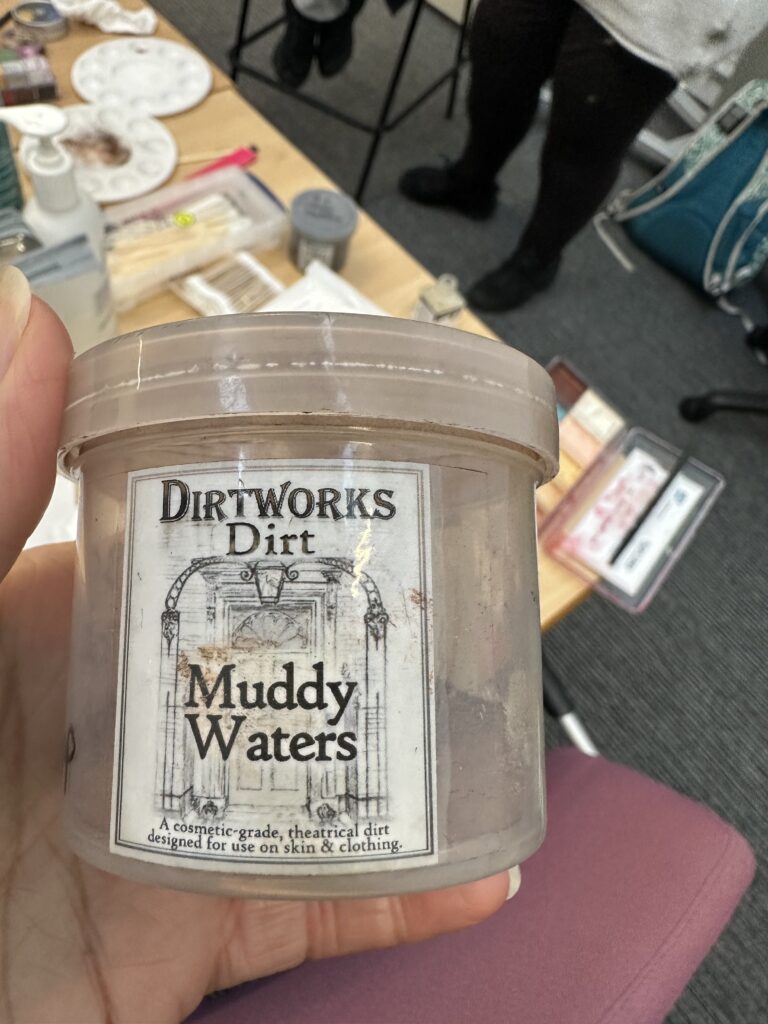
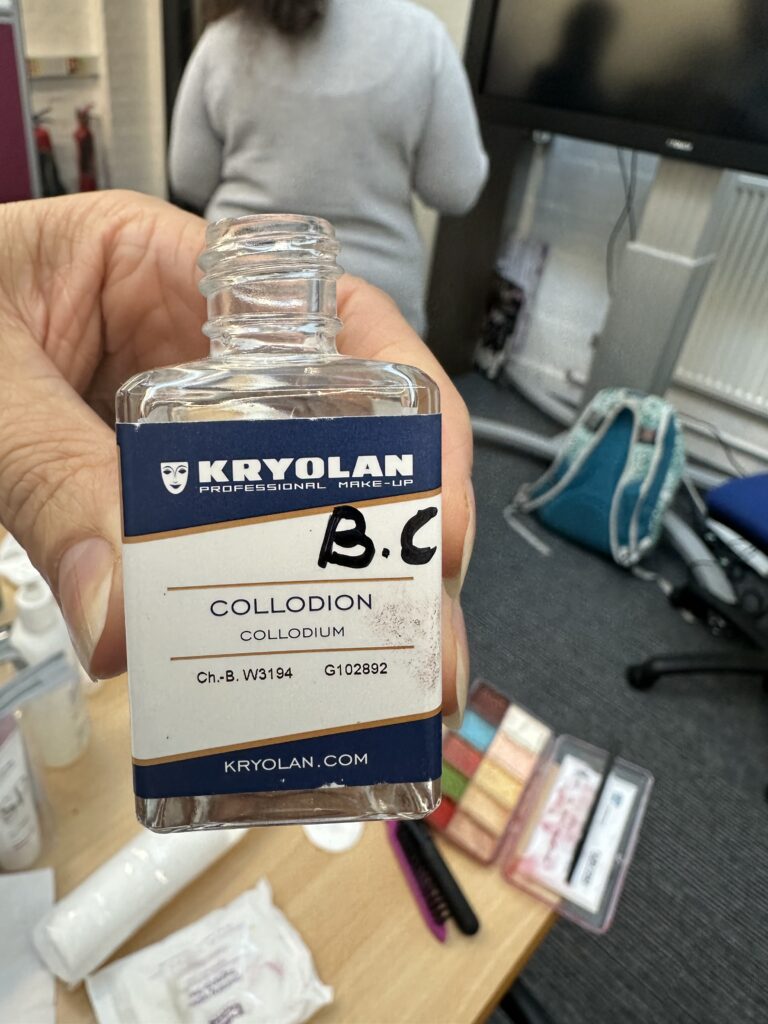
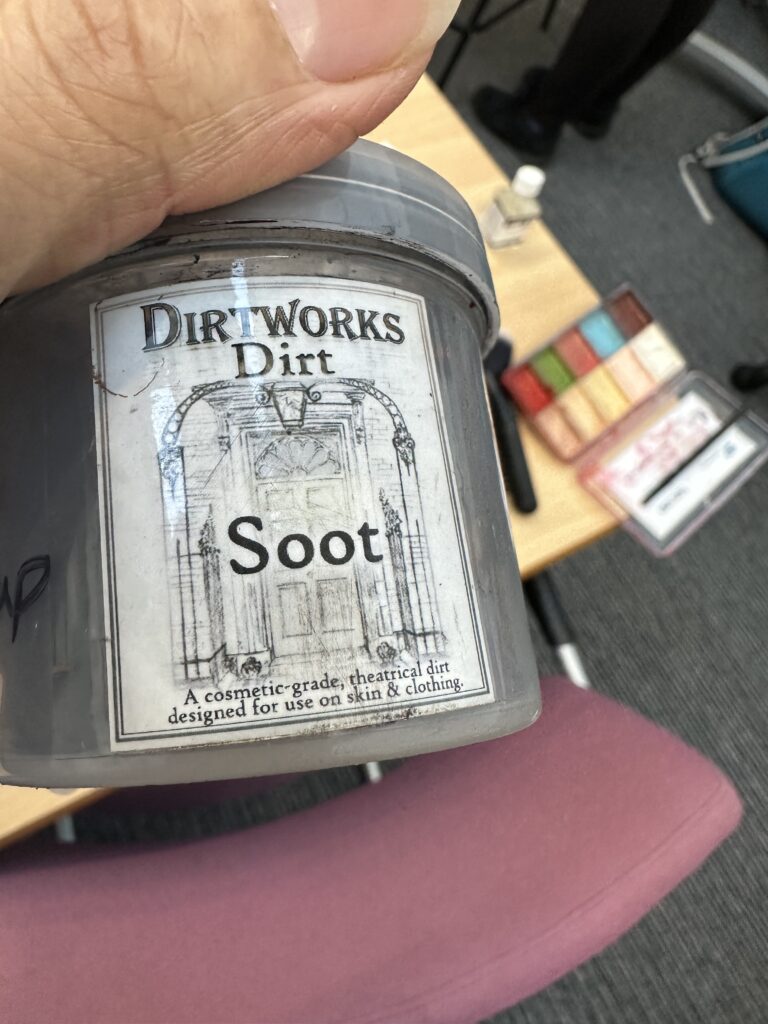
Today we had a lesson with Jaz on how to dirty down skin and hair using different products.
PRODUCTS USED
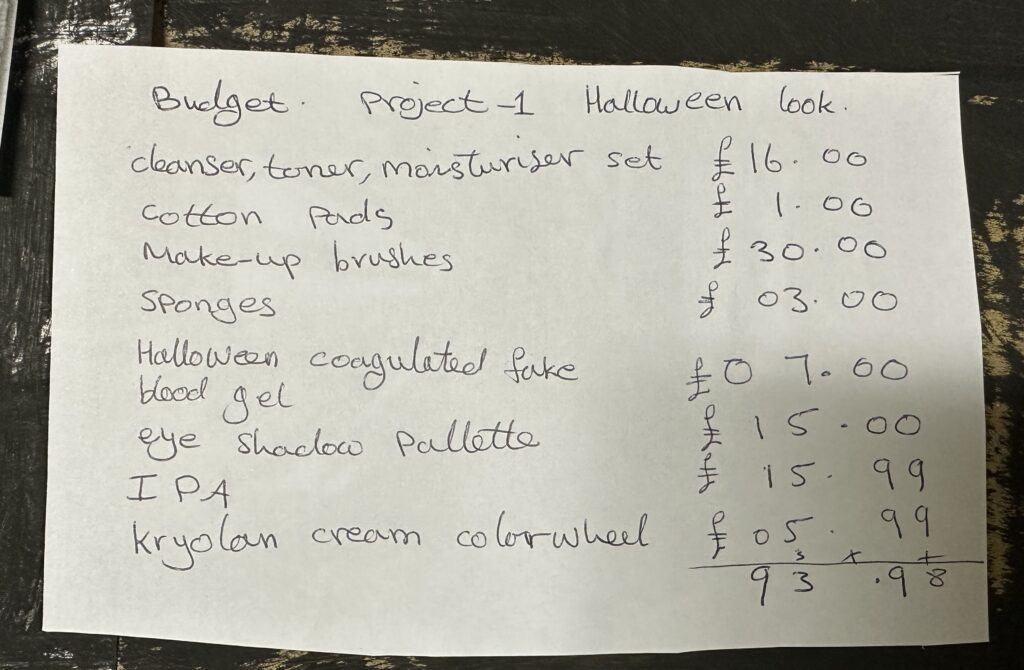
Project – 1 Final look Mood-board
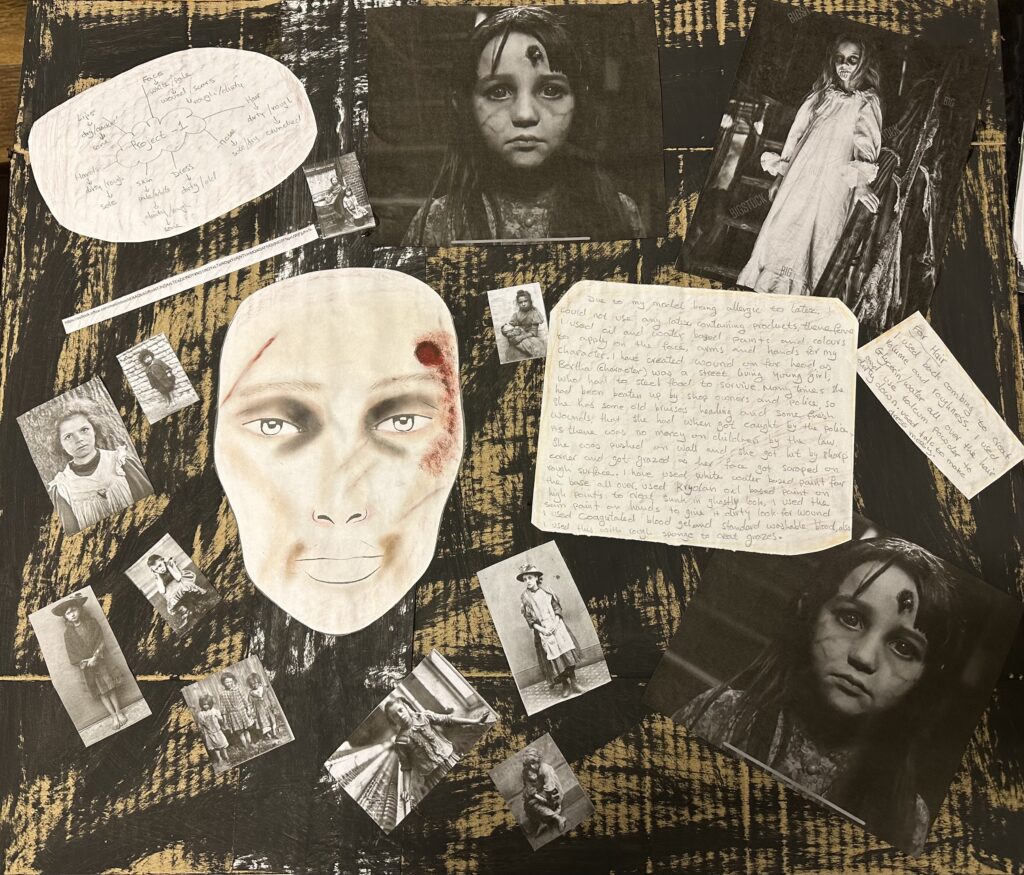
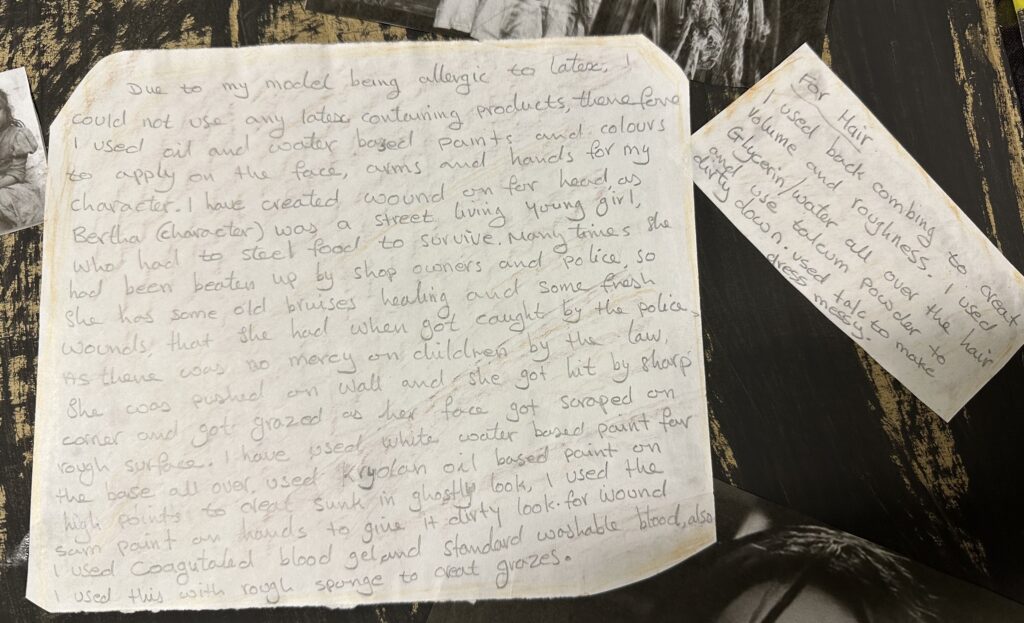
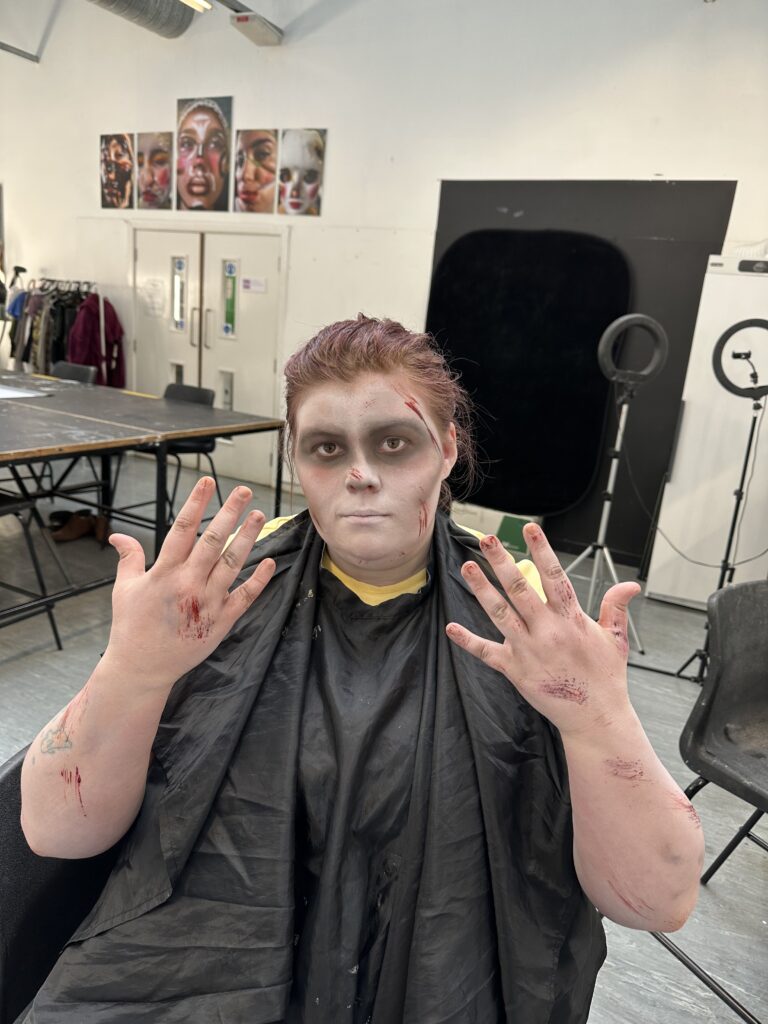
Practice look on second character, but both of us agreed the first practice was better. and will keep eyebrows naturally light rather then making it bushy, it just looks out of place, and my model did not like the eyebrows being done so dark.
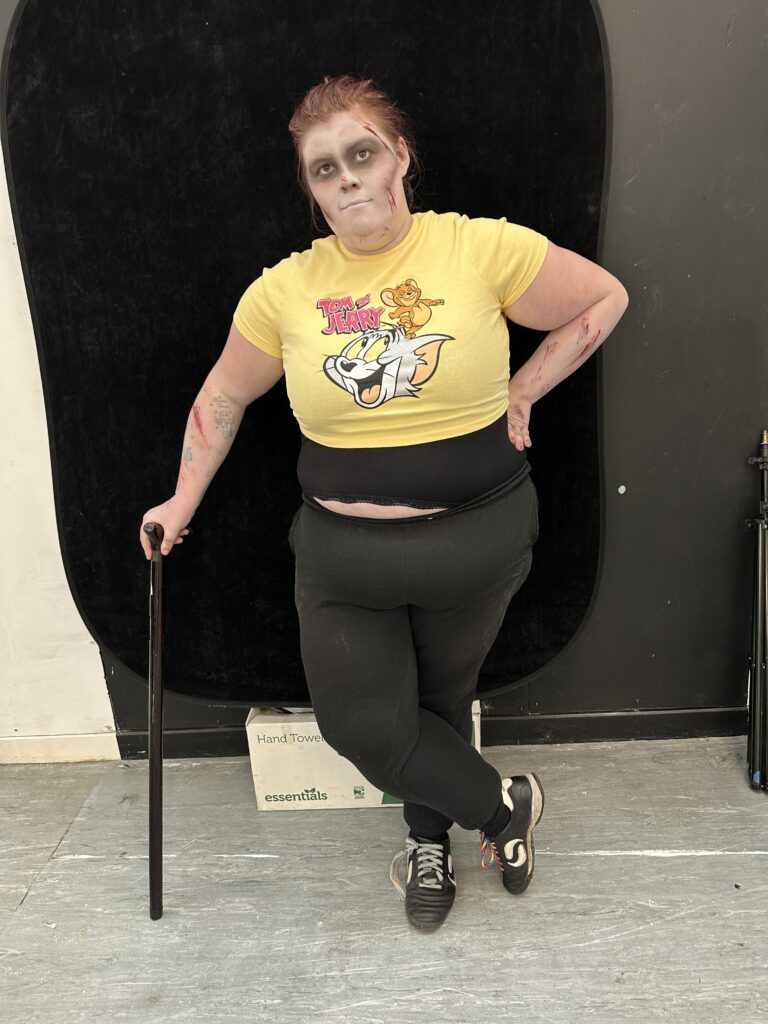
I have practiced hair on doll head. Hair was very greasy already and very sticky, so I washed and blow dried it. I curled hair to give body and brushed it out for puffiness, so back combing was not necessary. I have crunched up hair to give it messy look and did small Dutch plat at the bottom of hair and loosen out to again make it look messy that it has not been done for days. I used dry shampoo and tapped loose powder with a make up brush all over the head to make it look dirty.
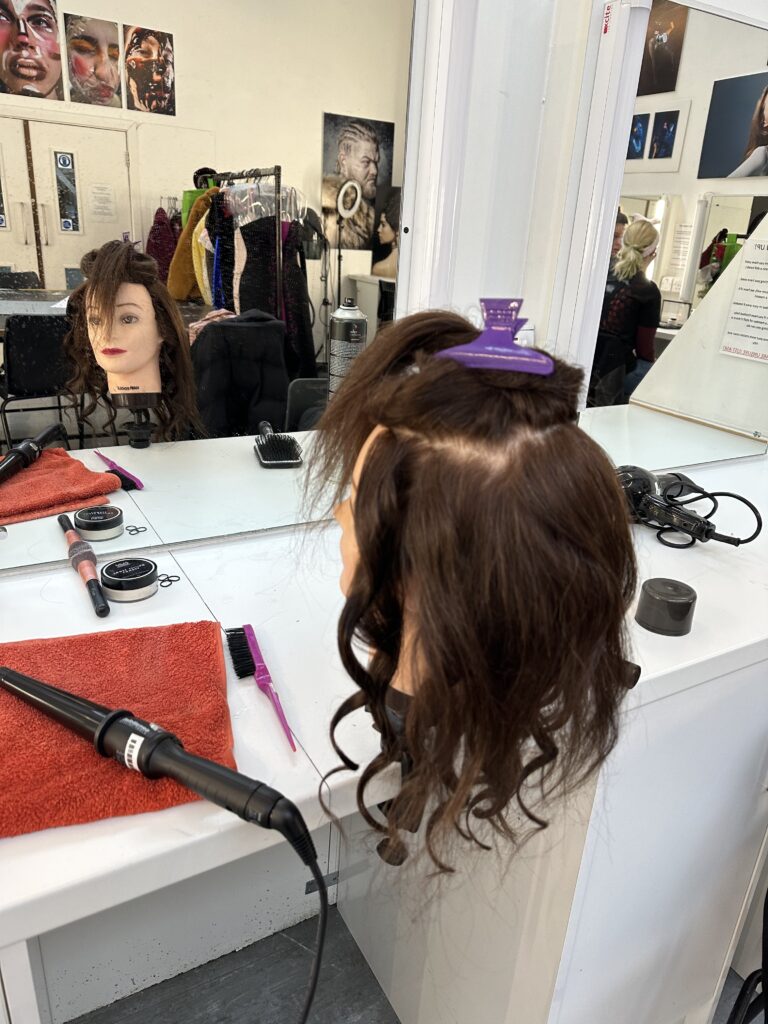
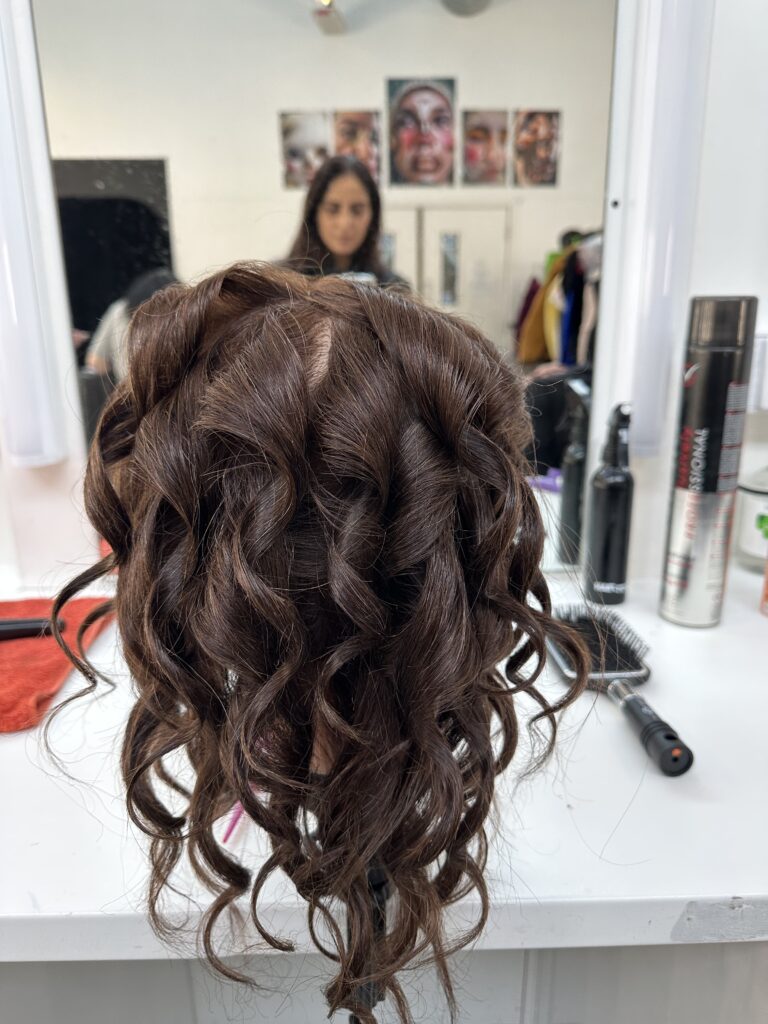
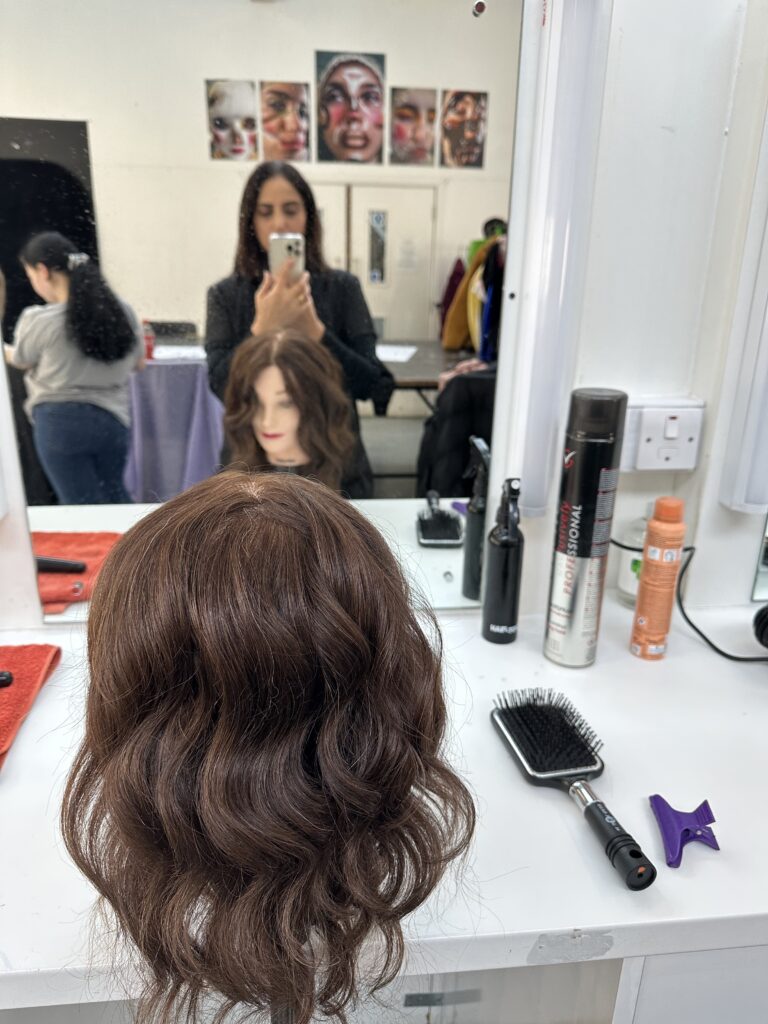


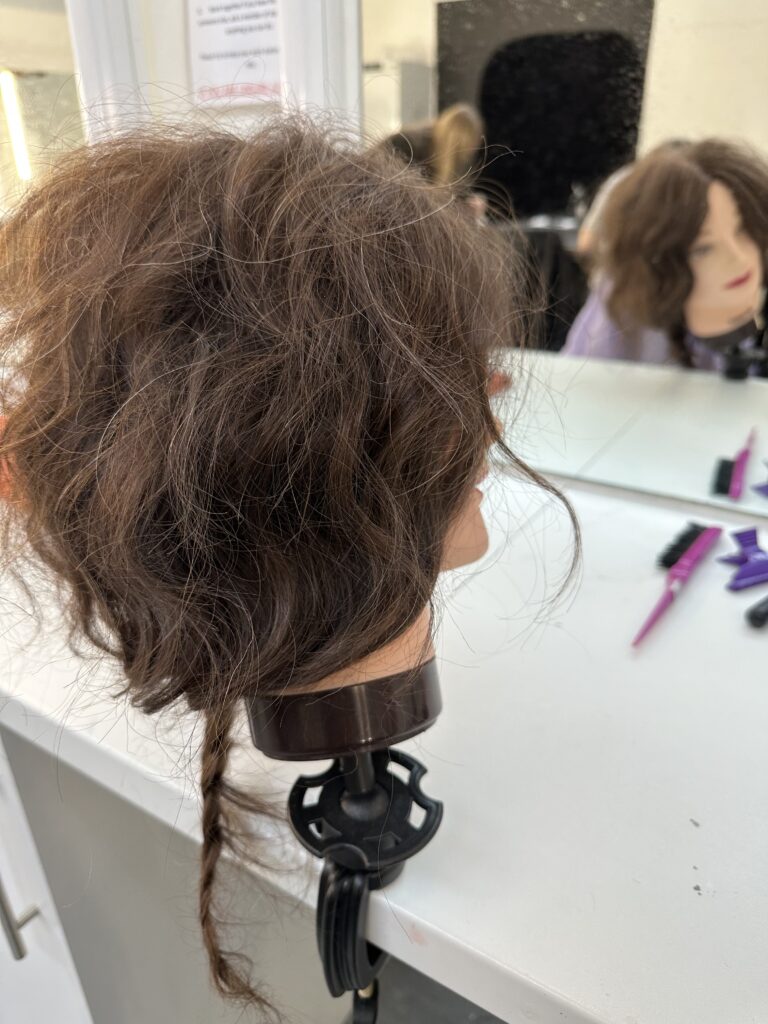
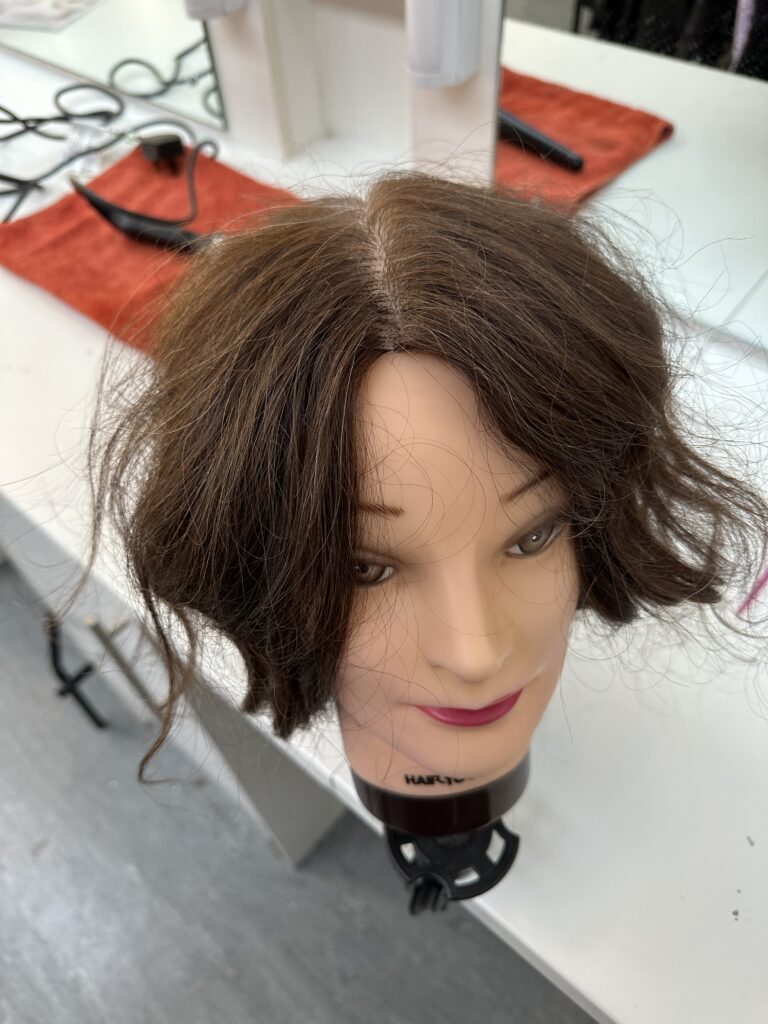
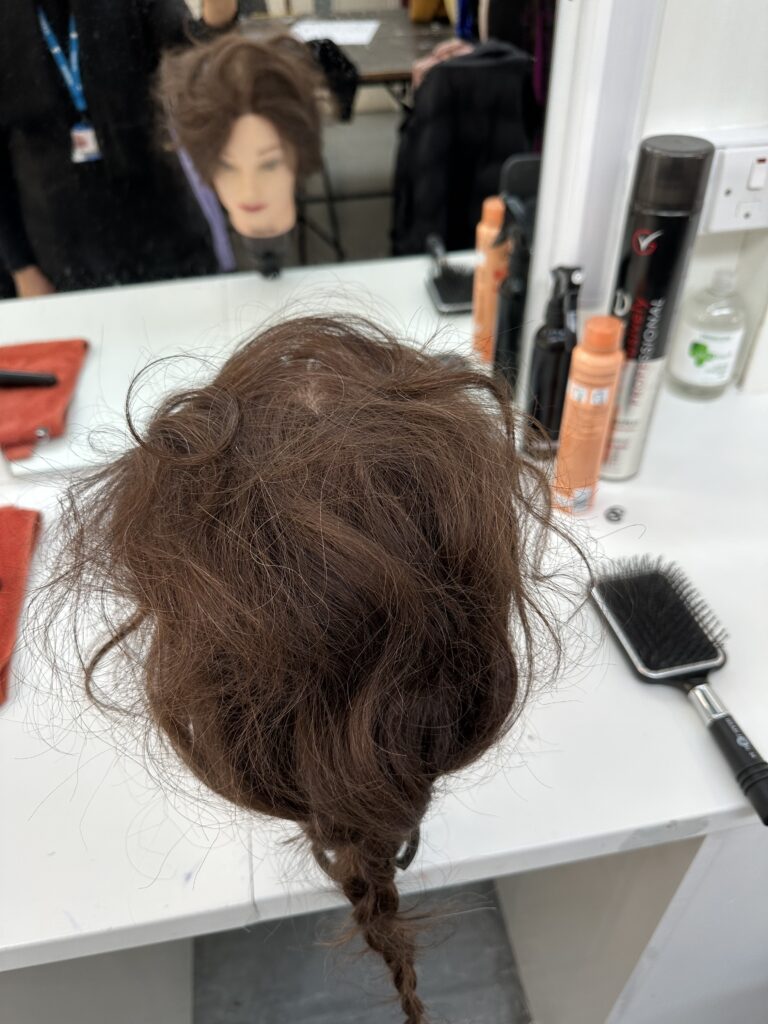
Feedback from Tutor
Alisa suggested I should look up at the Victorian time rough hair looks. She really liked the messy hair I created with added volume by hair dryer and curling also plated at the bottom.
